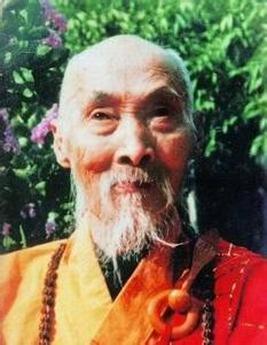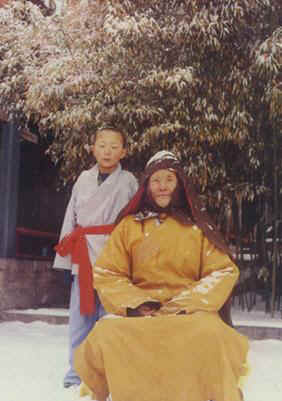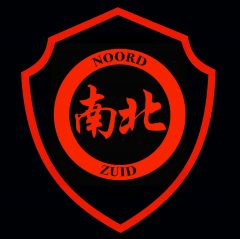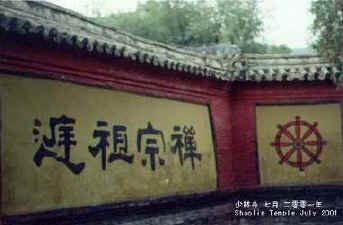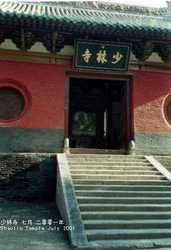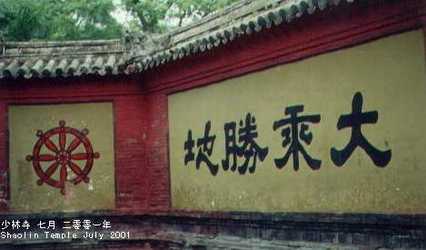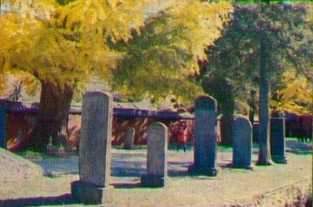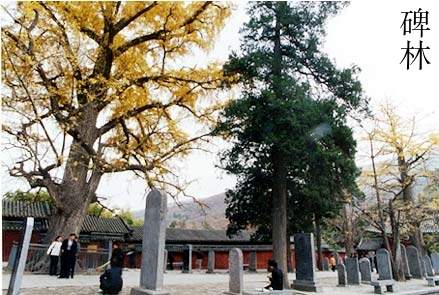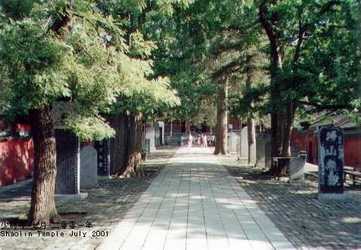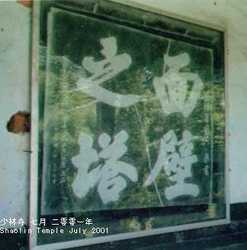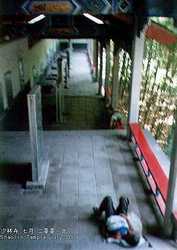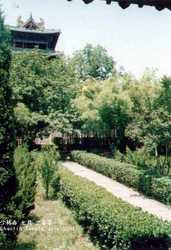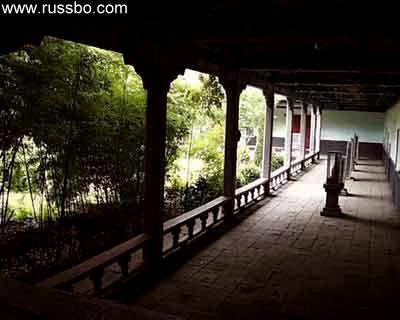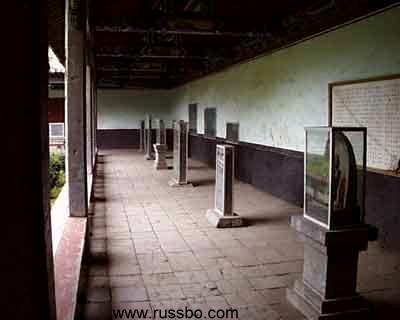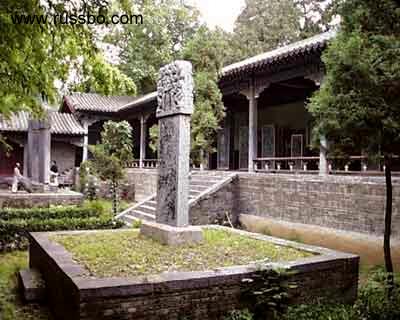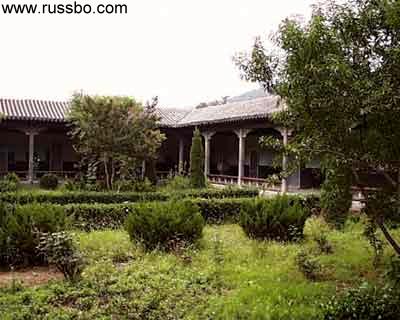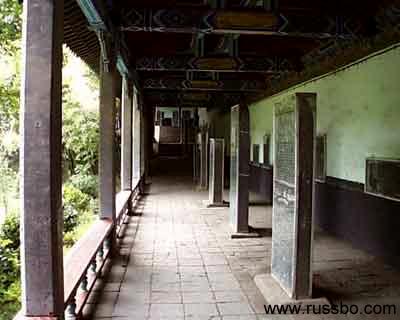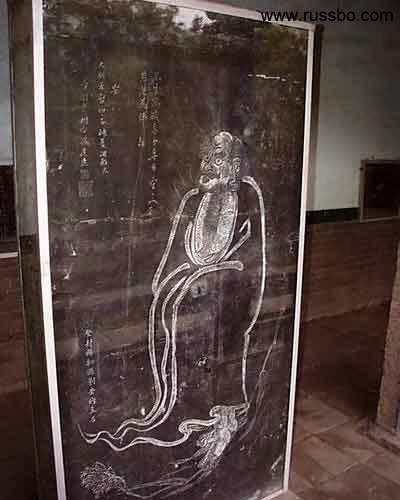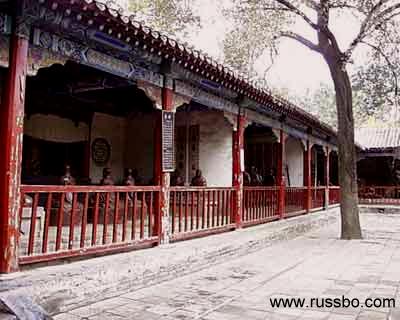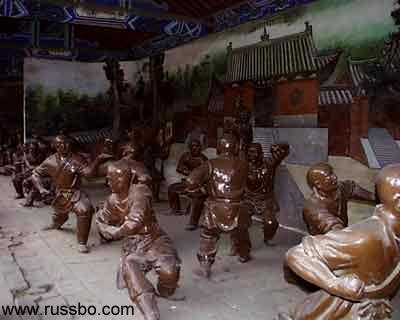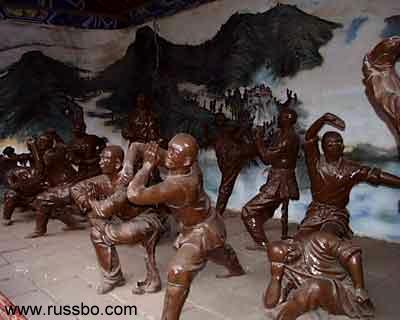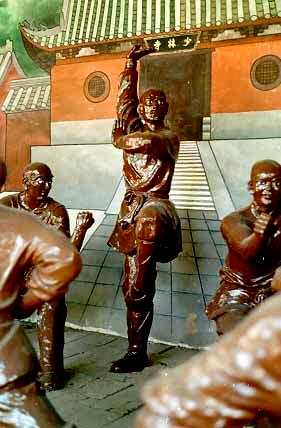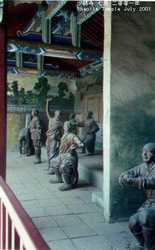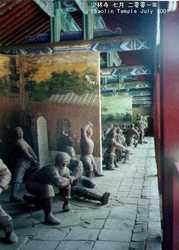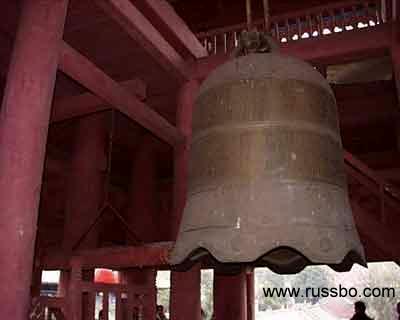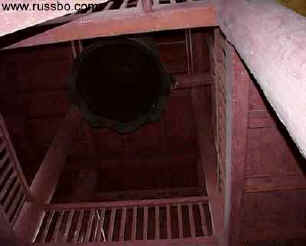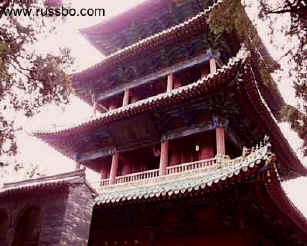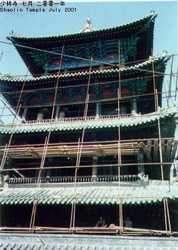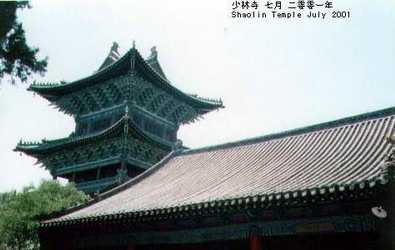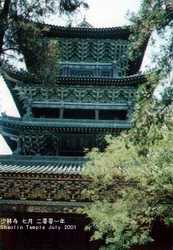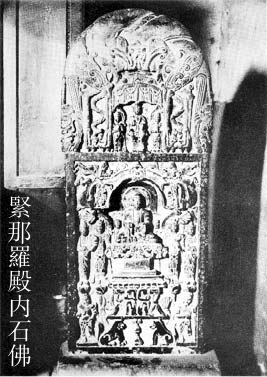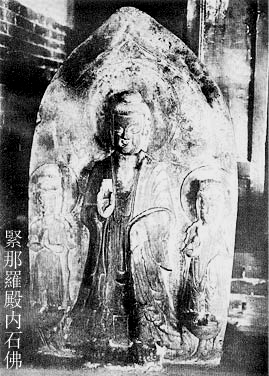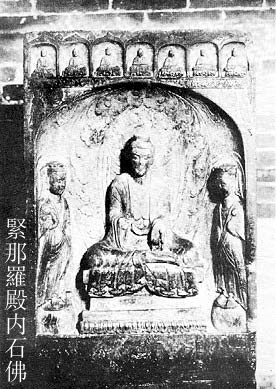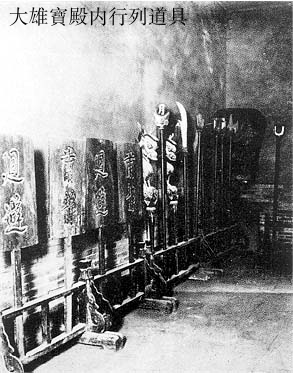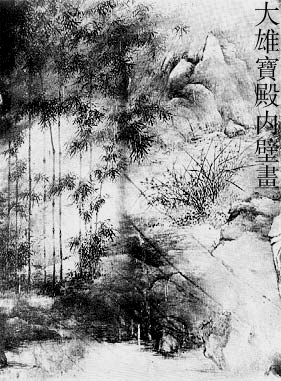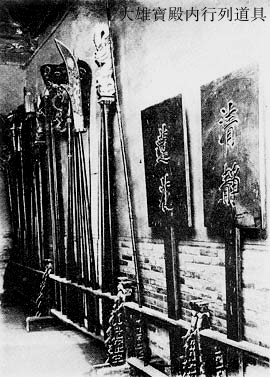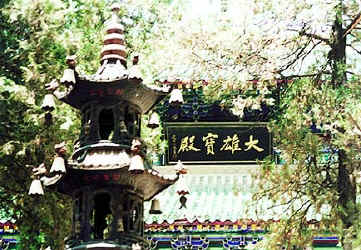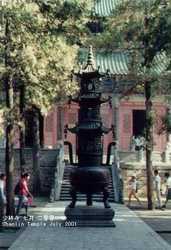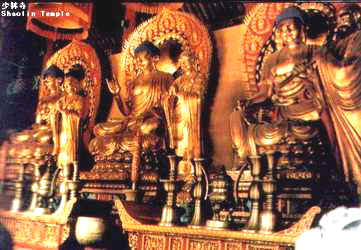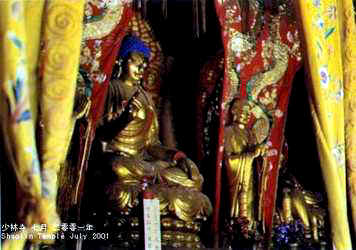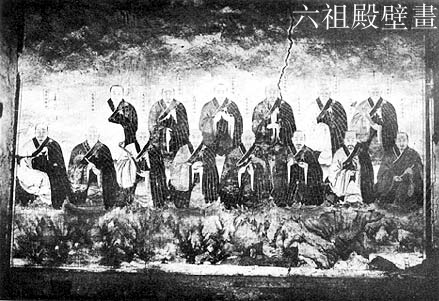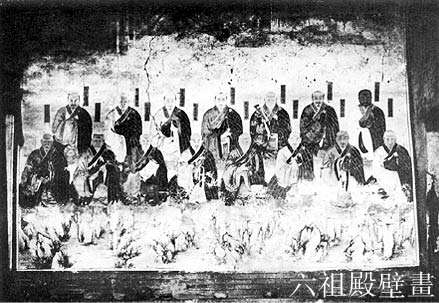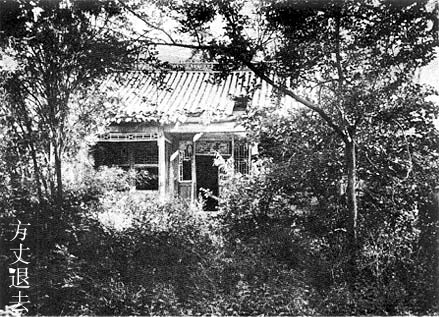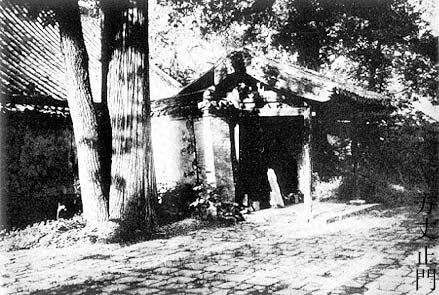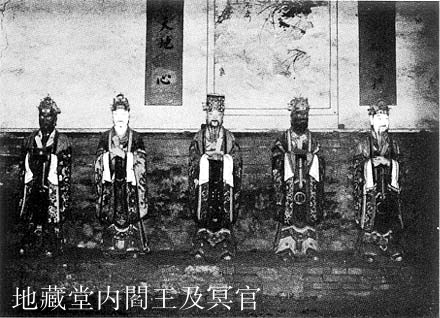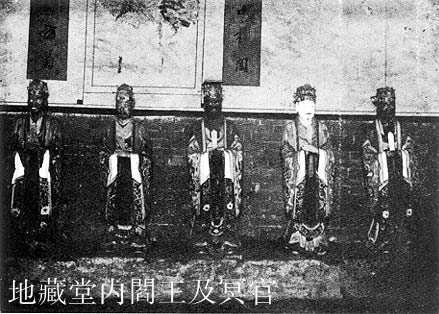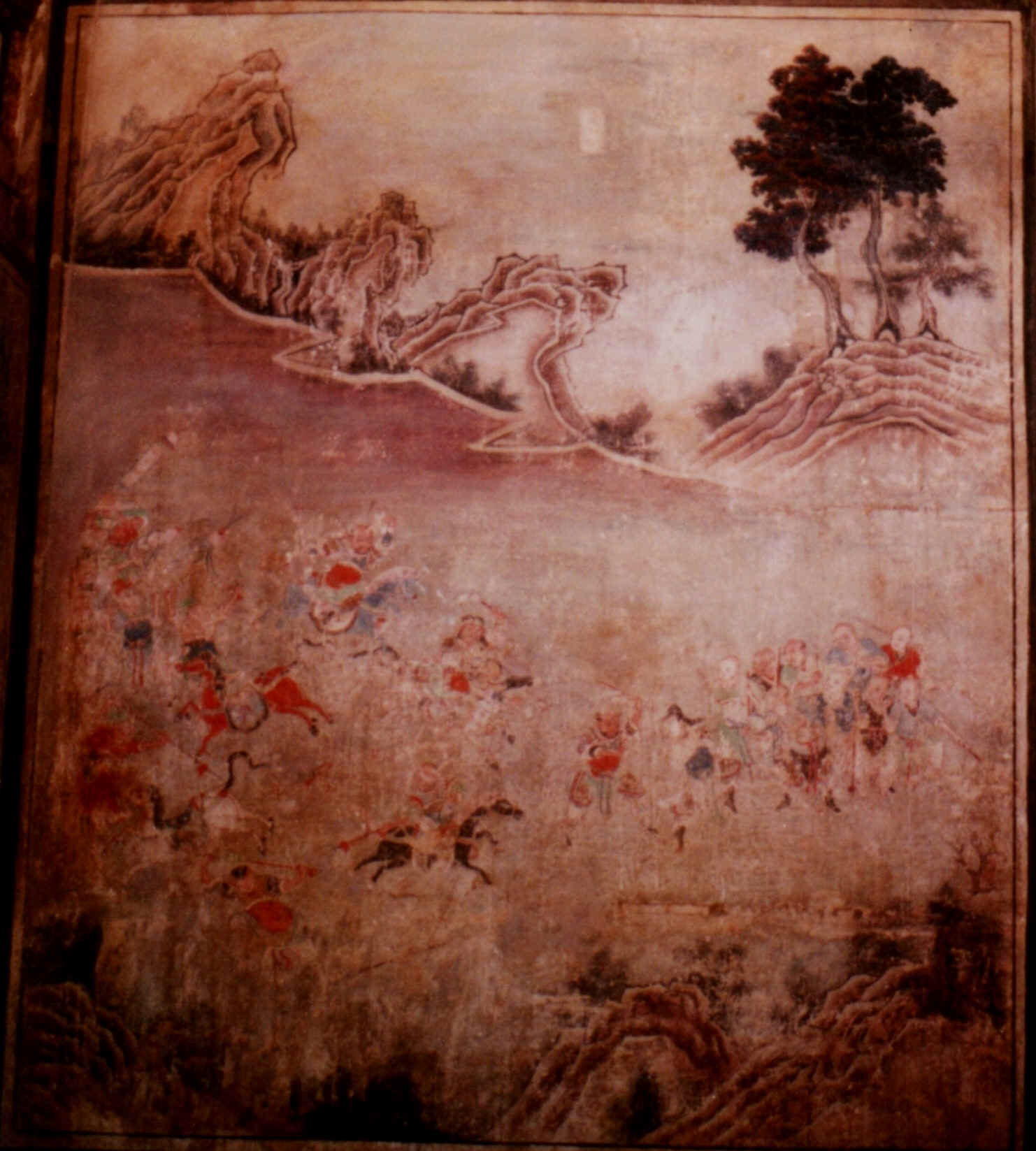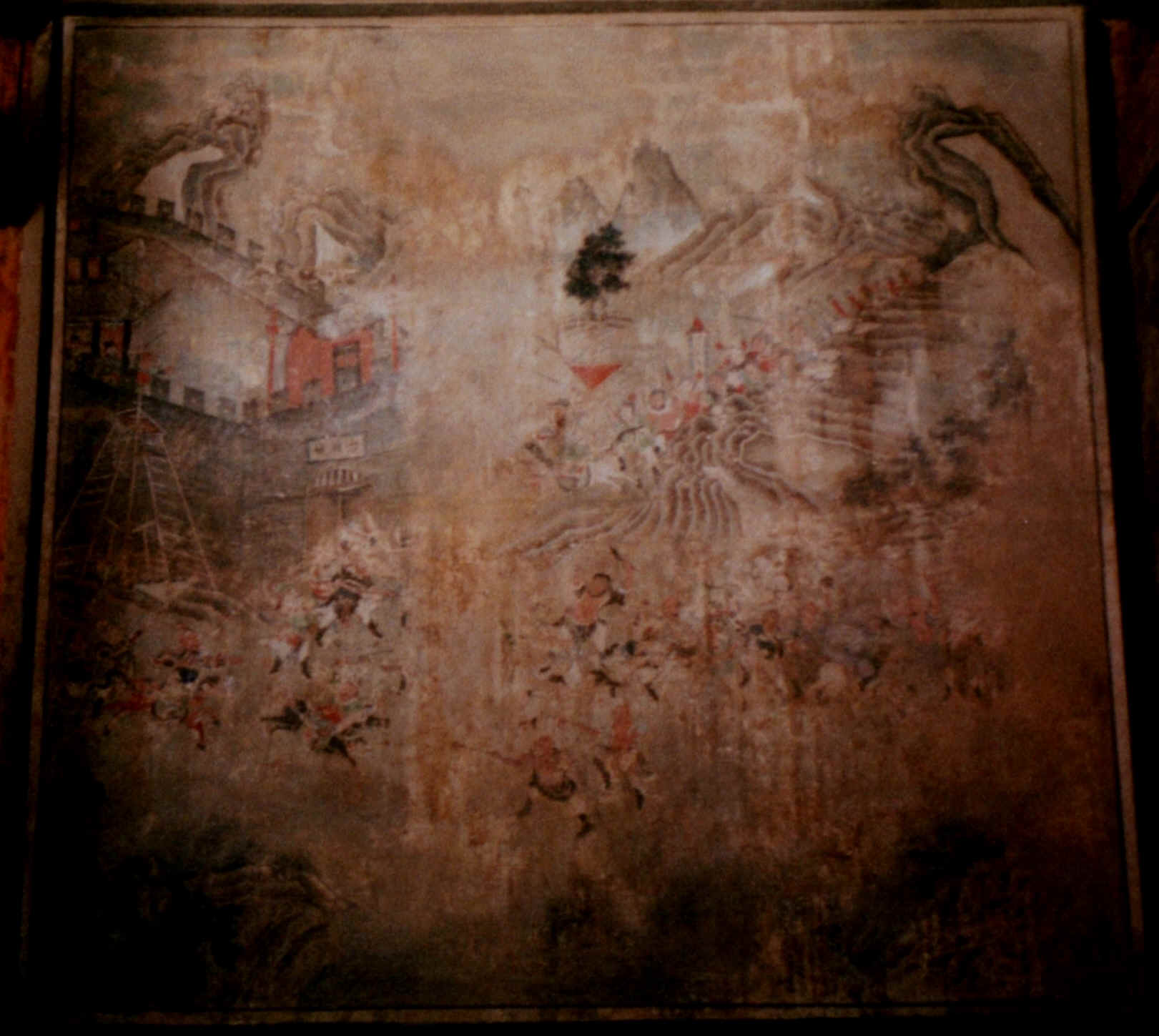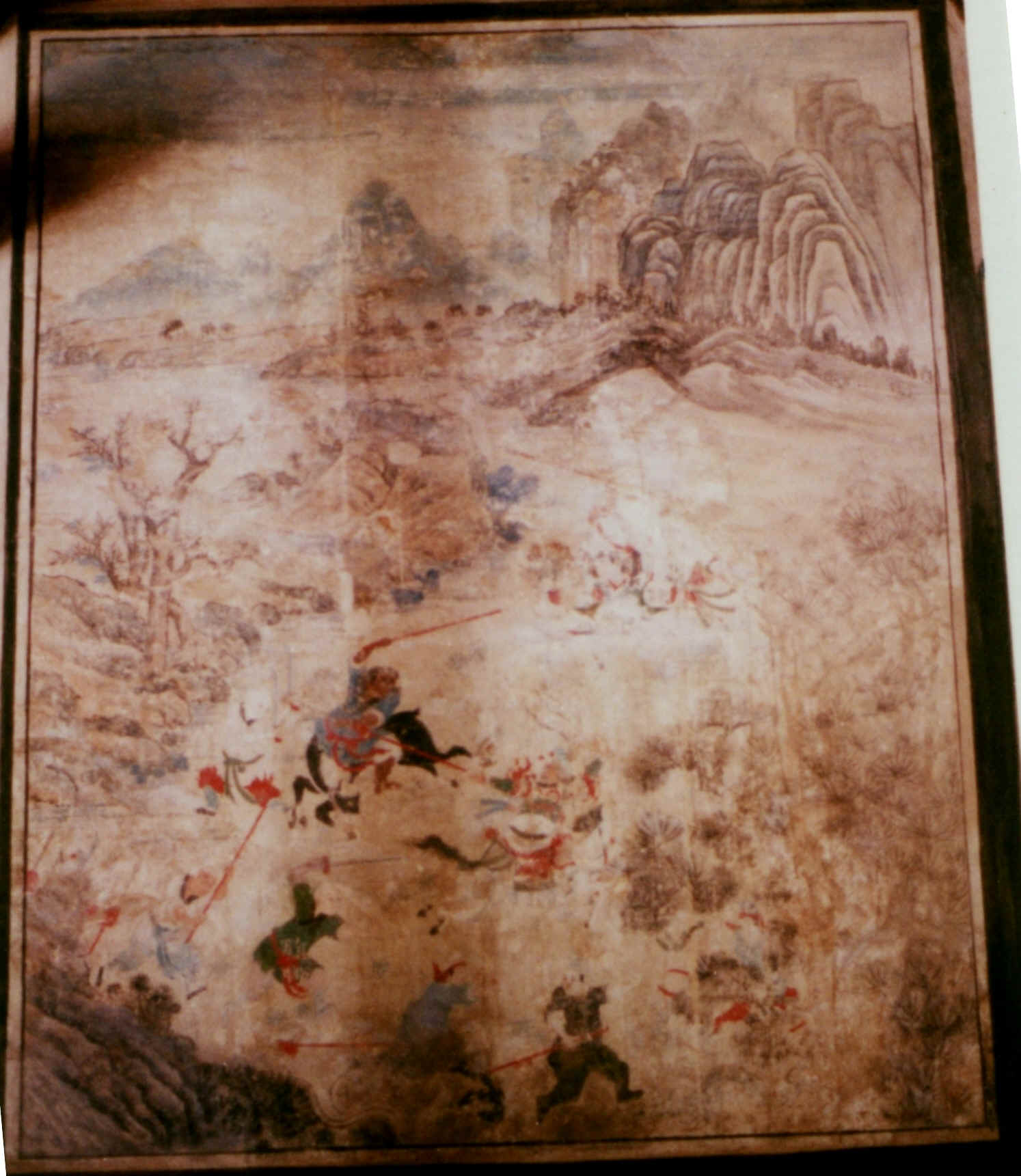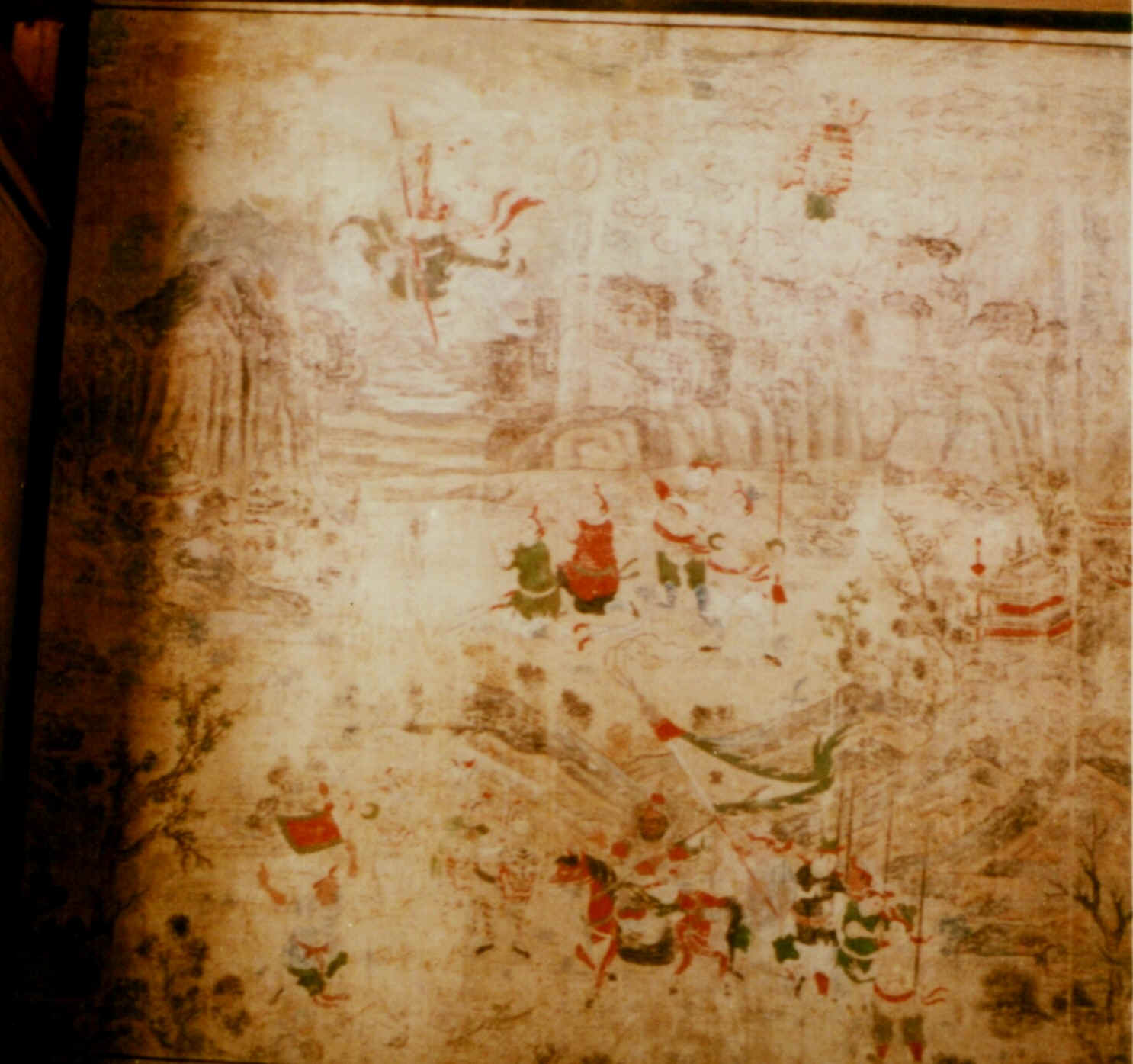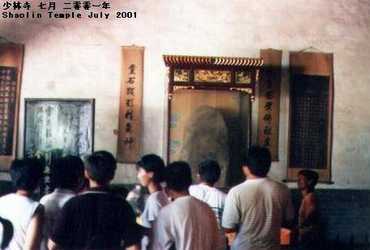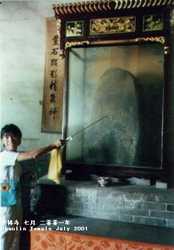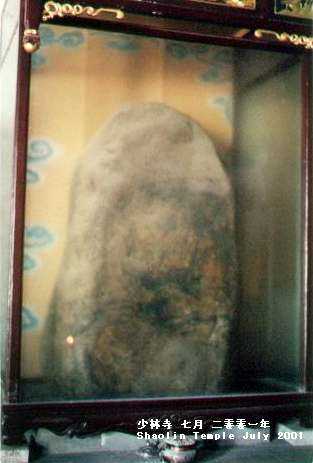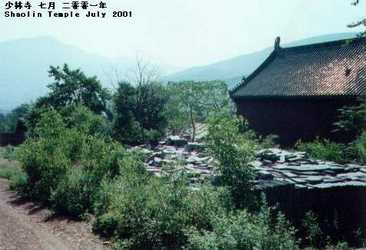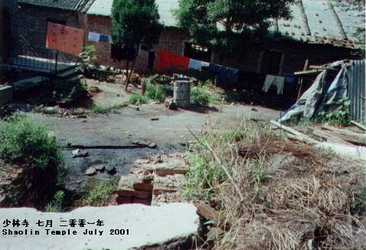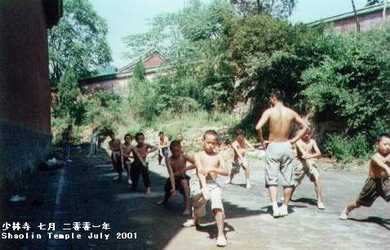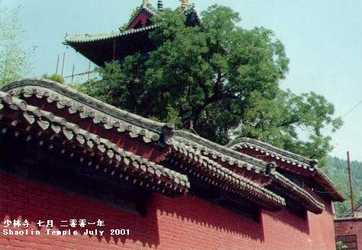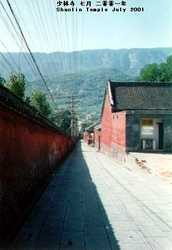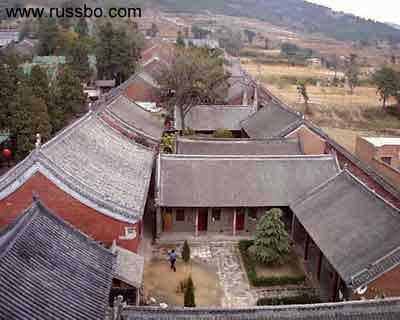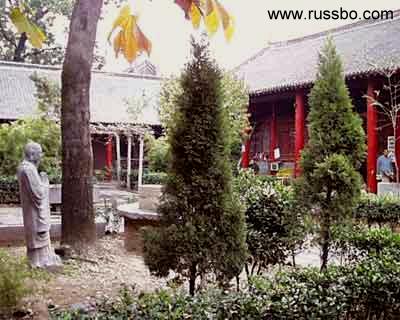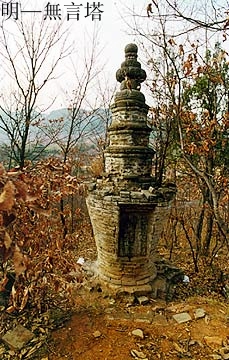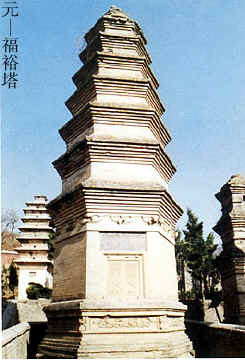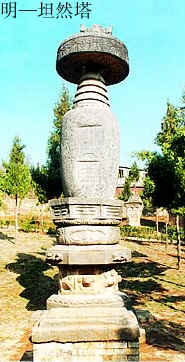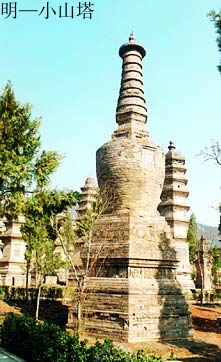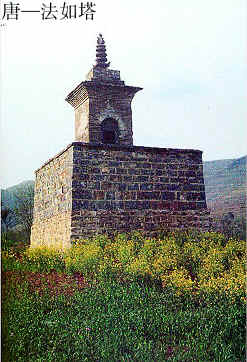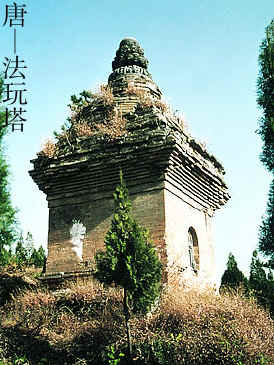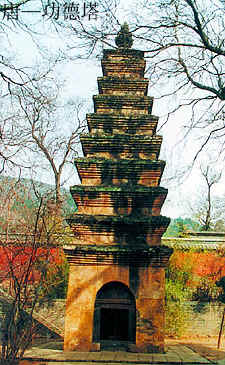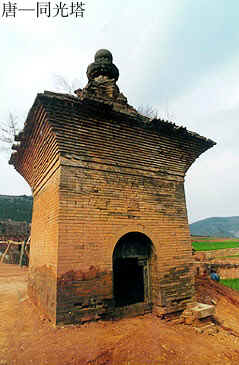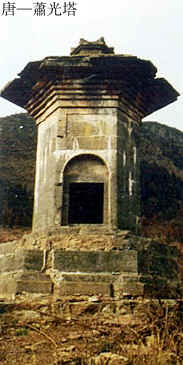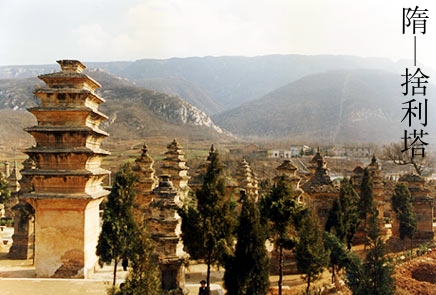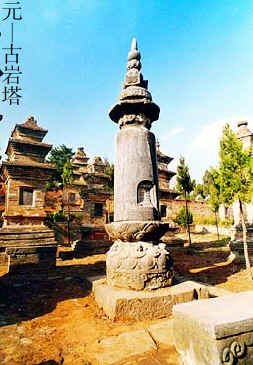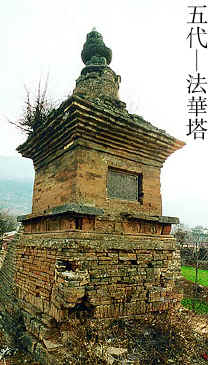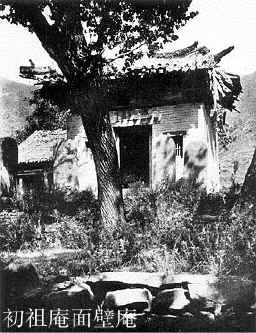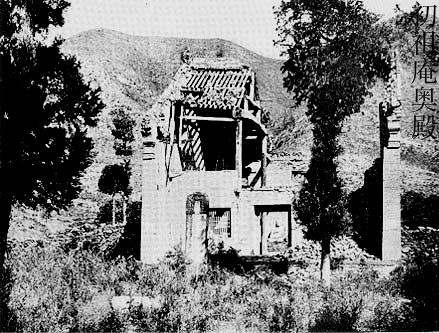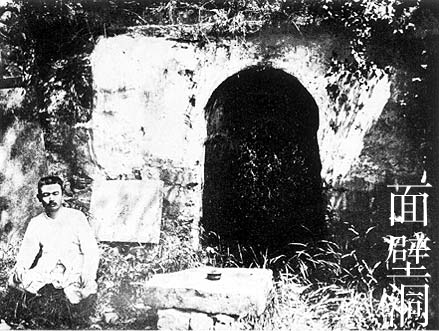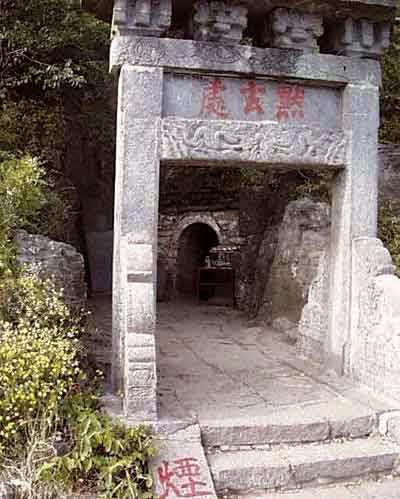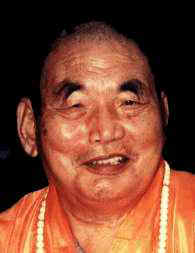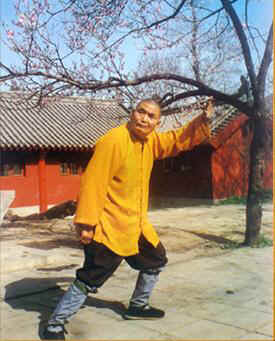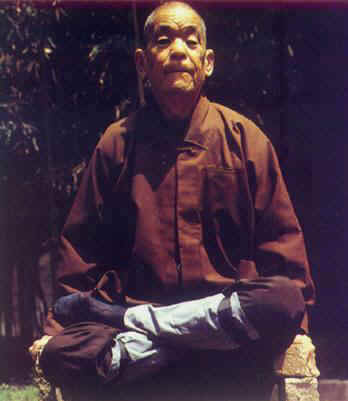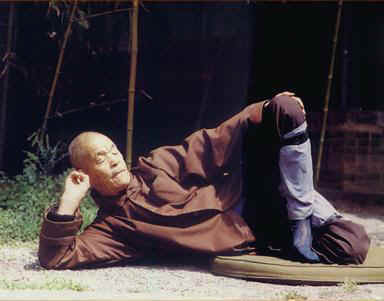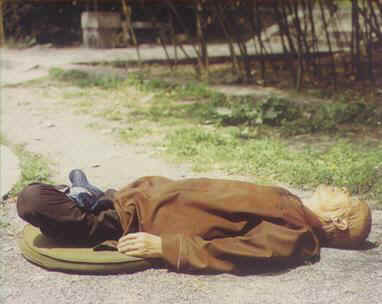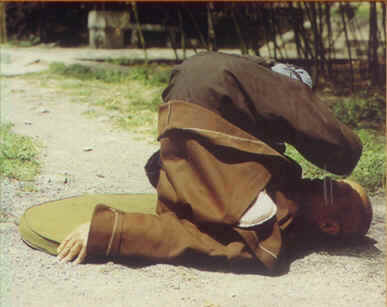Introduction
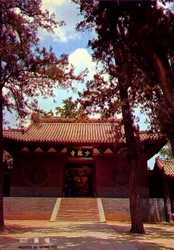

There is a Chinese saying that goes: ‘All martial arts under the sky, started in Shaolin. This is somewhat of an exaggeration, but like many Chinese sayings it does contain a grain of truth. China is a huge land and has since long an enormous population. The land that we know today consists of a mixture of people with many different linguistically and cultural traditions. For centuries they developed independently from each other. If we say that all the martial art systems in China come from one single tradition or temple. But we can’t deny that the Shaolin temple did have a big influence on the development all Chinese martial arts. Many say that Buddhism and boxing don’t combine. This is true and it is not true at the same time. Buddhism forbids damaging all living beings, but this is contradicted by an edict that teaches tolerance. Tolerance has been one of the biggest strengths of Buddhism for centuries. And this tolerance let to the fact that the martial arts training of the Shaolin temple, including weapon training, was accepted for over a thousand years.
Although the annals talk about many famous martial monks, its very likely that they were boxers first and lived between the temple monks, like so many other laymen. But still it is strange that Buddhism, know for it’s peaceful character, accepted the martial arts and that the Shaolin temple, birthplace of Chan Buddhism, is best known for its martial arts.
The temple was, and still is, located on the countryside and is was important that one could defend oneself in remote areas. Only if you’re healthy and strong could you survive; meditation alone was not enough to survive!
The monks went so far as to use weapons to defend themselves. How can they train themselves in killing human beings, when generally speaking monks lead an peaceful and quite life? Some say that the ones that were killed by the monks weren’t humans, but demons in the shape of human beings. In many Buddhist legends, monks, or Buddhists kill dozens and dozens of demons, and they use martial arts to do this. In one story the Heavenly Prince Dharmapala kills demons and monsters with his powerful pestle. If one looks it at it that way, than the monks of the Shaolin temple are doing nothing wrong and are the martial arts for them just as important as practicing Chan, some say they ARE one.
The Shaolin temple is situated in Henan province, 13 kilometers outside the village of Dengfeng. It was build in 496 at the foot of Songshan Mountain, under edict of Emperor Xiao Wen of the Northern Wei Dynasty (386-534).
Map showing Dengfeng City, Shaolin temple surroundings
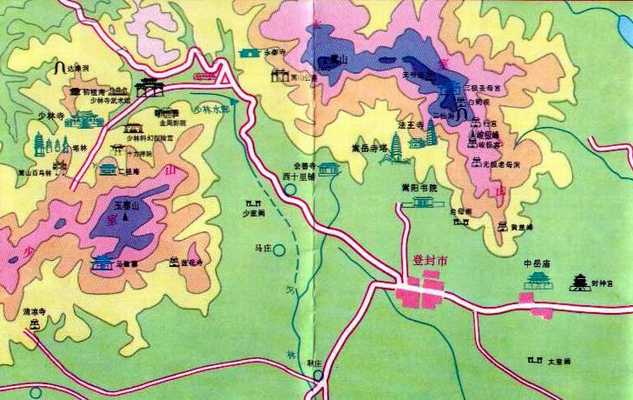
Songshan Mountain has many peaks and hills. The temple is located at the foot of Wu Ru Feng (Five-breast Peak), North of Shaoshi Mountain. The temple faces the south. Eastwards lies Taishi Mountain, and to the North one can find the Huanyuanguan path, which was a important passage before the modern road were paved. In front of the entrance of the temple flows the Shaoxi river (of Shaoshixi), this protects the temple according to the rules of Fengshui against bad influences. The temple is build on the spot were once was a ‘young forest’. Many say that that’s the reason why the temple is called Shaolin Si, which means ‘Young Forest Temple’. A different explanation for the name says that it stands for the monks living in the temple; like young trees they bend when forced, but they won’t break. Yet another explanation can be found in the book ‘Songshan Mountain’ of Jing Rizhen, dating from the early Qing Dynasty: ‘Shaolin means woods on Shaoshi Mountain inside Songshan Mountain Area’.
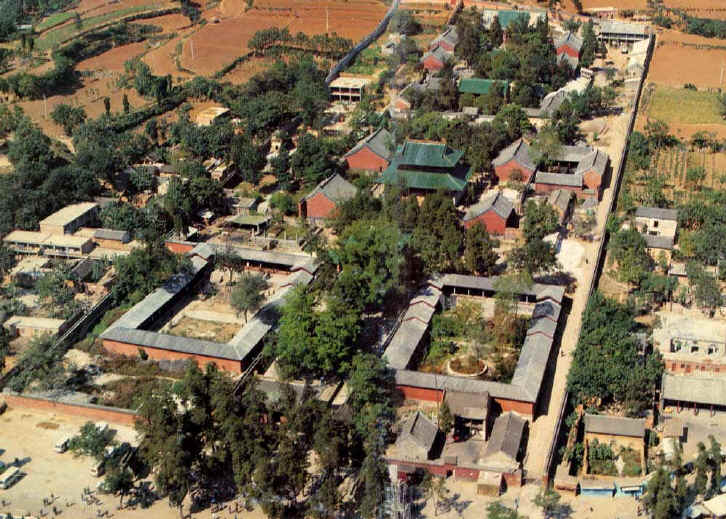
Birdseye view from the temple before many reconstructions were carried out. Notice the absence of the Bell and Drum towers.
Shaolin Cun; Shaolin Village
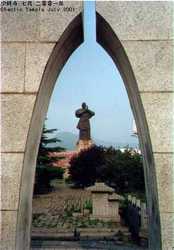
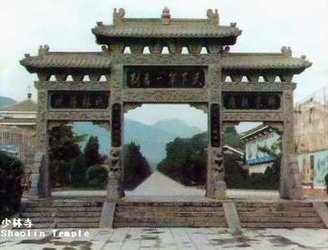 The first sign of Shaolin Village is this rather raunchy statue of a saluting Shaolin monk at the edge of the village. Actually at the beginning of the long road which leads to the Shaolin temple. After this statue many shops and restaurants and eventually the archway on the right; ‘Shaolin is the number one temple under heaven’. This is also the place where you buy your ticket of 45 Yuan RMB (2001). You have to buy a ticket to enter this erea. You can try saying that you live at the Shaolin Wushu Hotel, in which case they will probably let you trough. Or take the road on the right just before the archway, which leads up to the hotel after which you’re ‘inside’ as well. But you still have to have a ticket to actually get in the temple itself. Although there are ways to get in for free as well; put on your kung fu outfit and just barge in through the front gate like you go there everyday. If somebody stops you then you should tell them that you study at Shaolin. The next question will be who your teacher is. That is the part where it gets tricky; if you know a name of a monk who teaches and you have the guts to tell them you study under him, they will let you through. If they check it, you’re done for… Another way of answering is of course in English (or any other language than Chinese for that matter), important is to keep walking when you talk, even when they grab you under the arm. Pull gently, keep smiling, keep walking and you’re in!
The first sign of Shaolin Village is this rather raunchy statue of a saluting Shaolin monk at the edge of the village. Actually at the beginning of the long road which leads to the Shaolin temple. After this statue many shops and restaurants and eventually the archway on the right; ‘Shaolin is the number one temple under heaven’. This is also the place where you buy your ticket of 45 Yuan RMB (2001). You have to buy a ticket to enter this erea. You can try saying that you live at the Shaolin Wushu Hotel, in which case they will probably let you trough. Or take the road on the right just before the archway, which leads up to the hotel after which you’re ‘inside’ as well. But you still have to have a ticket to actually get in the temple itself. Although there are ways to get in for free as well; put on your kung fu outfit and just barge in through the front gate like you go there everyday. If somebody stops you then you should tell them that you study at Shaolin. The next question will be who your teacher is. That is the part where it gets tricky; if you know a name of a monk who teaches and you have the guts to tell them you study under him, they will let you through. If they check it, you’re done for… Another way of answering is of course in English (or any other language than Chinese for that matter), important is to keep walking when you talk, even when they grab you under the arm. Pull gently, keep smiling, keep walking and you’re in!

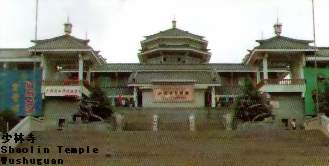 Anyway, after a minute or two walking after you passed the archway you will see the infamous Wushu Guan (Wushu school) and the hotel that comes with it. This it the only hotel that officially takes foreigners, but I found out later that cheap-ees just beyond the temple gates also shovel in foreigners on occasions. The school also gives demo’s at 14.00 h, but only when there are enough busses with (foreign) tourists around.
Anyway, after a minute or two walking after you passed the archway you will see the infamous Wushu Guan (Wushu school) and the hotel that comes with it. This it the only hotel that officially takes foreigners, but I found out later that cheap-ees just beyond the temple gates also shovel in foreigners on occasions. The school also gives demo’s at 14.00 h, but only when there are enough busses with (foreign) tourists around.
To the right is the stadium of the the school.
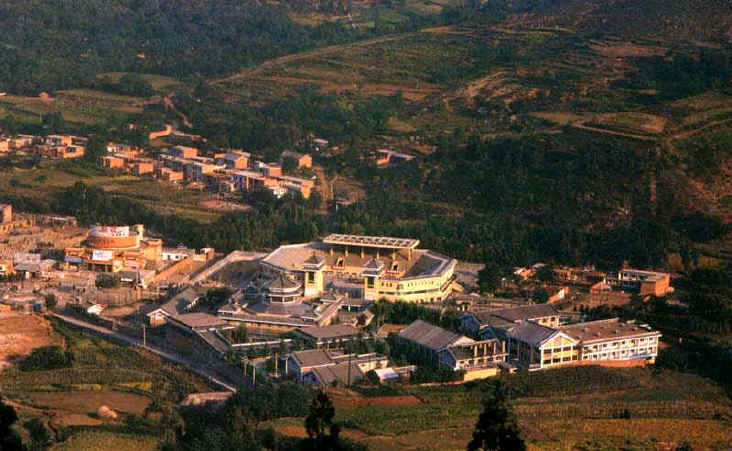
Birdseye view of the Wushu Guan area.
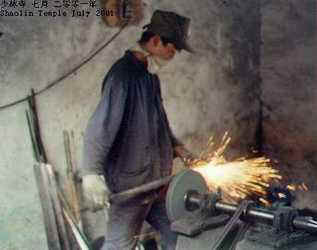 Also part of the compound of the Wushu Guan is a weapon factory and shop. They say that whey made all the weapons they sell, but I only say straight swords being made and the other (long) weapons looked a lot like Longquan weapons.
Also part of the compound of the Wushu Guan is a weapon factory and shop. They say that whey made all the weapons they sell, but I only say straight swords being made and the other (long) weapons looked a lot like Longquan weapons.
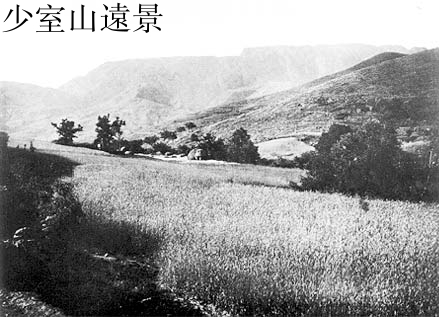
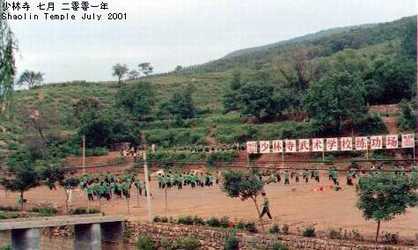 Almost 100 years ago, the surroundings of Shaolin looked a lot different from how it looks now. Now buildings of any kind. Although the pic below, apart from the Wushu School, doesn’t look that different, does it now?
Almost 100 years ago, the surroundings of Shaolin looked a lot different from how it looks now. Now buildings of any kind. Although the pic below, apart from the Wushu School, doesn’t look that different, does it now?
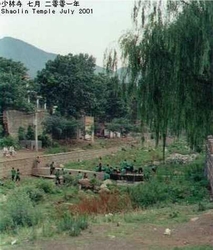
There used to be a lot of water in the stream running in front of the temple. But Henan Province is, just like many other parts of China, slowly drying up. In the little water that is left, students of the numerus schools around the temple wash their clothes, their bodies and …other things.
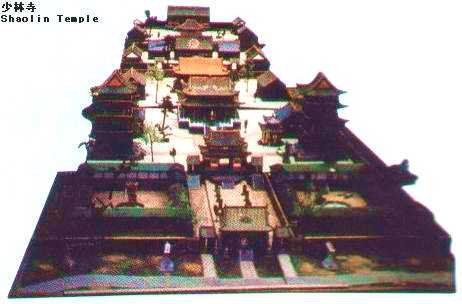
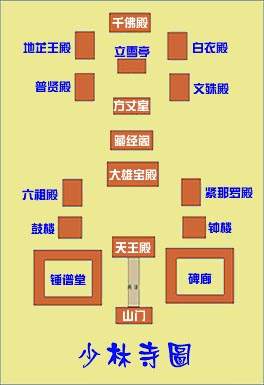
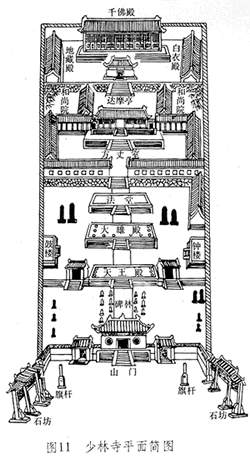 Then, suddenly, the main gate of the Shaolin temple emerges. The first thing you see is the Shaolin Si Shan Men; Entrance to the Shaolin Temple.
Then, suddenly, the main gate of the Shaolin temple emerges. The first thing you see is the Shaolin Si Shan Men; Entrance to the Shaolin Temple.
Shaolin Village was totally destroyed shortly after my visit.
Shaolin Si Shan Men; The Entrance of Shaolin Temple
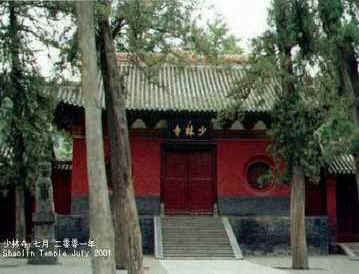 The Entrance to the temple consists of a main gate and two side gates flanking it. The main gate is constructed on a brick terrace (2 meters above ground) with single eaves and an exquisitely modified gable roof. It was build in 1735, in the reign of Emperor Yongzheng of the Qing Dynasty.
The Entrance to the temple consists of a main gate and two side gates flanking it. The main gate is constructed on a brick terrace (2 meters above ground) with single eaves and an exquisitely modified gable roof. It was build in 1735, in the reign of Emperor Yongzheng of the Qing Dynasty.
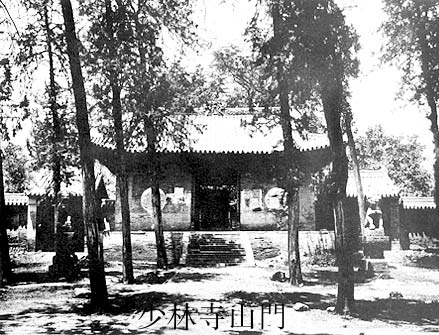
B/W picture shows the Entrance at the turn of the century. Notice the white colored window frames and the absence of the entrance sign.
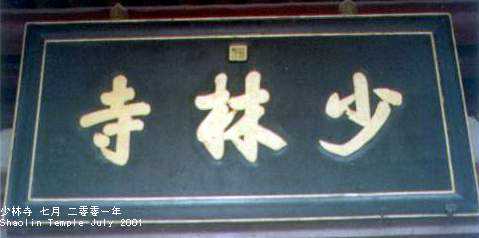 Above the lintel one sees a black horizontal board inscribed with three Chinese characters in golden relief ‘SHAO LIN SI’ (Shaolin temple). The board is 90 by 193 cm. Above the character LIN is carved Emperor Kang Xi’s seal: ‘Kang Xi Yu Bi Zhi Bao’ (Emperor Kangxi has favoured by writing in person hereon).
Above the lintel one sees a black horizontal board inscribed with three Chinese characters in golden relief ‘SHAO LIN SI’ (Shaolin temple). The board is 90 by 193 cm. Above the character LIN is carved Emperor Kang Xi’s seal: ‘Kang Xi Yu Bi Zhi Bao’ (Emperor Kangxi has favoured by writing in person hereon).
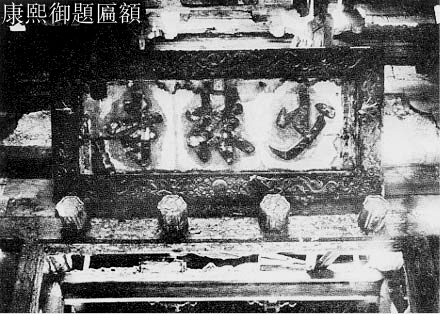 According to the History of Shaolin Temple, this board used to hang above the front door of the Tianwang Dian ‘Hall of Heavenly Kings’; it was removed to the present place after the hall was burnt down. On careful observation, one finds that the brushwork on the present board for the lower parts of the characters ‘SHAO’ and ‘SI’ are not harmonious. This is the result of later renovations. That the board survived the fire is already a wonder on itself.
According to the History of Shaolin Temple, this board used to hang above the front door of the Tianwang Dian ‘Hall of Heavenly Kings’; it was removed to the present place after the hall was burnt down. On careful observation, one finds that the brushwork on the present board for the lower parts of the characters ‘SHAO’ and ‘SI’ are not harmonious. This is the result of later renovations. That the board survived the fire is already a wonder on itself.
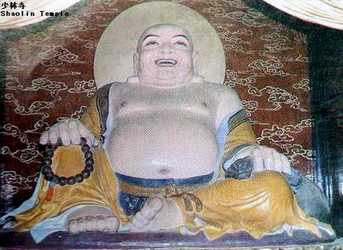
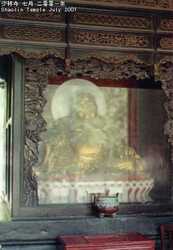 Passing the Entrance one sees Maitreya smiling his welcome. This clay statue of Maitreya is kept in a shrine behind glass and has a gold colour. In the past it had lifelike colours.
Passing the Entrance one sees Maitreya smiling his welcome. This clay statue of Maitreya is kept in a shrine behind glass and has a gold colour. In the past it had lifelike colours.
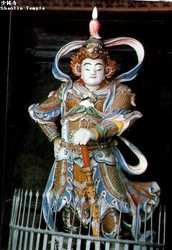
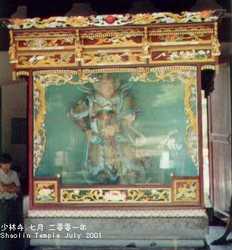 Behind Maitreya is a figure of Wei Tuo (Skanda) as a principal guard of Buddhism. He too is now enshrined behind glass.
Behind Maitreya is a figure of Wei Tuo (Skanda) as a principal guard of Buddhism. He too is now enshrined behind glass.
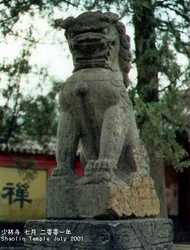
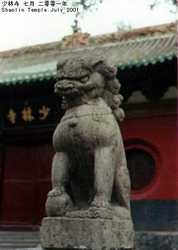 On either side of the Entrance is a 1.67 meter high stone lion crouching on a 1.75 meter platform. Adding ancient flavour to the place. Next to each lion is a flagpole.
On either side of the Entrance is a 1.67 meter high stone lion crouching on a 1.75 meter platform. Adding ancient flavour to the place. Next to each lion is a flagpole.
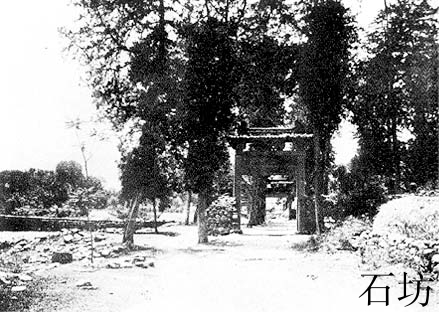 In front of the Entrance, on the left and right side, stand two gateways constructed in the Ming Dynasty. These two gateways, standing homogonously, look the same in appearance. Each has one arch and two pillars, 5.85 meters high and 1.95 meters wide. The tops of both gateways are decorated with carved ridges and tile furrows. Beneath the eaves four modified birch leave shaped brackets support the tops. The stone horizontal laths, square columns and thresholds imitate the style of wooden structures. The main laths are decorated with relief of ‘two lions playing with silk balls’ and ‘two phoenixes greeting the sun’, very popular in the Ming and Qing Dynasties. The front and back sides of the horizontal laths and columns are carved with inscriptions and antithetical couplets related to the history of the temple. Picture on the left shows the archways at the turn of the century: no splay walls yet.
In front of the Entrance, on the left and right side, stand two gateways constructed in the Ming Dynasty. These two gateways, standing homogonously, look the same in appearance. Each has one arch and two pillars, 5.85 meters high and 1.95 meters wide. The tops of both gateways are decorated with carved ridges and tile furrows. Beneath the eaves four modified birch leave shaped brackets support the tops. The stone horizontal laths, square columns and thresholds imitate the style of wooden structures. The main laths are decorated with relief of ‘two lions playing with silk balls’ and ‘two phoenixes greeting the sun’, very popular in the Ming and Qing Dynasties. The front and back sides of the horizontal laths and columns are carved with inscriptions and antithetical couplets related to the history of the temple. Picture on the left shows the archways at the turn of the century: no splay walls yet.
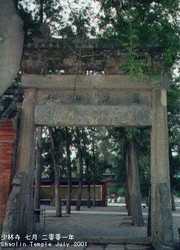 On the eastern part of the eastern archway are in horizontal inscriptions ‘Fountain Head of Zen’. The couplet reads:
On the eastern part of the eastern archway are in horizontal inscriptions ‘Fountain Head of Zen’. The couplet reads:
The very centre under Heaven, the topmost noble mountains;
The greatest treasure in the heart, the source of Most-taught Zen
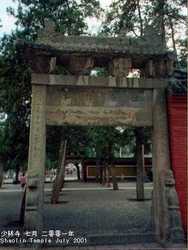
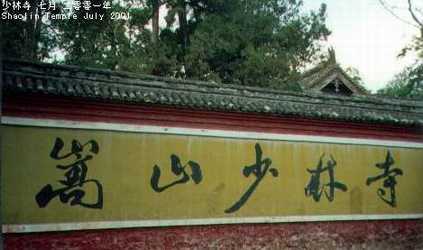 On the western part of the eastern archway is the horizontal inscription ‘founded by Ba Tuo’ (Ba Tuo or Buddhabadhra was the first eminent Indian monk coming to Shaolin temple. Though not the initiator of Chan sect Buddhism, he was one of its founders.) There is no antithetical couplet on this column.
On the western part of the eastern archway is the horizontal inscription ‘founded by Ba Tuo’ (Ba Tuo or Buddhabadhra was the first eminent Indian monk coming to Shaolin temple. Though not the initiator of Chan sect Buddhism, he was one of its founders.) There is no antithetical couplet on this column.
The eastern part of the west archway has the horizontal inscription ‘Holy Place of the Great Vehicle’. The ‘Great Vehicle’ or Mahayana, and the ‘Lesser Vehicle’ or Hinayana, are two schools under Buddhism. The Chan sect of Buddhism or Zen, taught by Damo in China came from the ‘Great Vehicle’. The ‘Great Vehicle’ is figuratively used for tidings sufferings over to eternal happiness; whereas the ‘Lesser Vehicle’ stresses on self cultivation and transcendence.
The couplet reads:
The heart’s set in the Cave, the knee-deep snow could but illuminate the transient form. Referring to Hui Ke’s first meeting with Damo.
The face toward the cliff, in silent night immortals piping drifted to the ear. Referring to Damo’s facing the wall meditation.
The western horizontal inscription of the western archway says ‘Song Chan Lin’ (Shaolin in Songshan, cradle of Chan), followed by the couplet:
Two pairs of jade wells, pure and limped, bathe the ageless moon.
A reference to the four wells caused to be there as a result of the magic touch of Hui Ke’s ‘tin cudgel’ down on the ground. All wells have different tastes.
Three dozen towering peaks, gree, mystic, glorify mid clouds.
From the smaller words between the horizontal inscriptions we get to know that the east archway was built in the fifth month of the twenty-second year during the reign of Emperor Jia Jing in the Ming Dynasty (1543), and the west archway was built in the autumn of the thirty-fourth year of the same reign (1555).
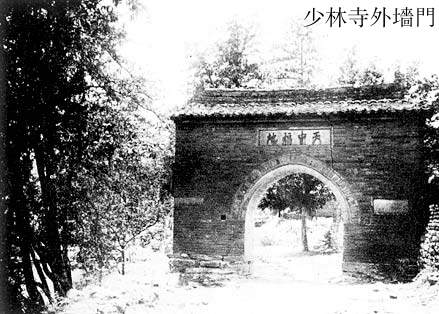 Part of an outer boundary wall.
Part of an outer boundary wall.
The Shaoxi bridge.
The Shaoxi bridge spans over the Shaoxi stream, with the Entrance looking upon it. An single span arch structure standing 5.55 meters above water and stretching 60 meters in length, its 4.29 meter high arch is further made into two curvatures. A dragoons head is carved on the west of the arch, its eyes widening, its mouth opening in readiness of drinking in all torrential floods. On either face of the arch is engraved an inscription, Built in the ninth month of Emperor Xuan Zong (about 1856).
Beilin; Forest of Stelae
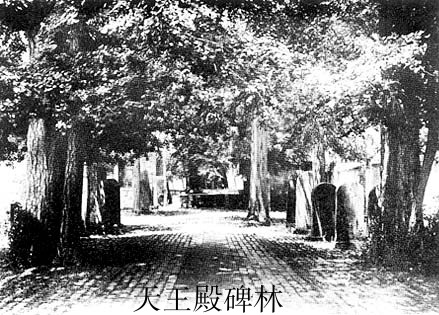 The scenery is lovely outside the temple; while inside stelae are like forest. When you pass the Entrance you are first greeted by a large number of stelea, or tablets, tall and short and in perfect order. Four rows of stone tablets stand neatly in perfect order. Four rows of stone tablets stand neatly on both sides as if welcoming visitors.
The scenery is lovely outside the temple; while inside stelae are like forest. When you pass the Entrance you are first greeted by a large number of stelea, or tablets, tall and short and in perfect order. Four rows of stone tablets stand neatly in perfect order. Four rows of stone tablets stand neatly on both sides as if welcoming visitors.
A poem from Jing Rizhen (Qing Dynasty):
Ancient steleat crowd the yard as if to comb the skies
Some tall, some short, some lean or slant, all boast great memories.
Dim light ‘neath shades of pines come flick’ring o’er the mystic lands
Believe or not, here most inscriptions came from masters hands
The stelea tells the visitor about important events from the past, poems about the temple, its surroundings and its martial arts and stelea in memory of master monks. There is a stelea that was unearthed in front of the Daxiong Hall in 1980.
Beilang; Corridor of Stelea
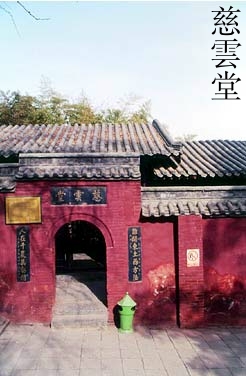
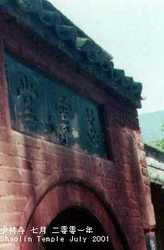 ‘In the Corridor of Stelea are erected more that 50 valuable stone tablets engraved during the various dynasties since the Northern Qi (550-570). In the Corridor of Stelea one can see images engraved in the Northern Qi period tablet with Tang Dynasty Emperor Li Shimin’s handwriting engraved on it, the inscribed poem written by Emperes Wu Zetian of the Tang Dynasty; a tablet with the image Guanyin drawn by Wu Daozi, a master artist of the Tang Dynasty, and also tablets with inscriptions handwritten by the four great calligraphers of the Song Dynasty: Su, Cai, Mi and Huang. All these tablets are priceless relics in Chinese calligraphy, painting and sculpture arts.’
‘In the Corridor of Stelea are erected more that 50 valuable stone tablets engraved during the various dynasties since the Northern Qi (550-570). In the Corridor of Stelea one can see images engraved in the Northern Qi period tablet with Tang Dynasty Emperor Li Shimin’s handwriting engraved on it, the inscribed poem written by Emperes Wu Zetian of the Tang Dynasty; a tablet with the image Guanyin drawn by Wu Daozi, a master artist of the Tang Dynasty, and also tablets with inscriptions handwritten by the four great calligraphers of the Song Dynasty: Su, Cai, Mi and Huang. All these tablets are priceless relics in Chinese calligraphy, painting and sculpture arts.’
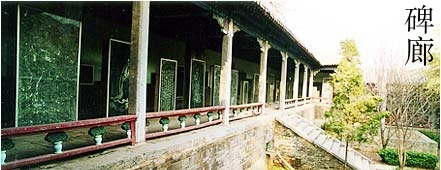
Chuipu Tang; ‘Chuipu Hall (Kung Fu Hall)’
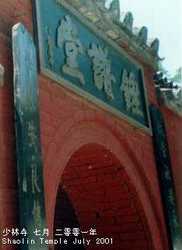
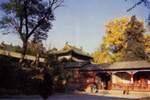 Chuipu Hall was built in 1984. It occupies an area of 870 square meter. Inside the hall there are altogether 236 wooden figures, clay figures and plaster figures showing Shaolin martial arts and the historical stories of the temple. These figures are divided into 14 groups.
Chuipu Hall was built in 1984. It occupies an area of 870 square meter. Inside the hall there are altogether 236 wooden figures, clay figures and plaster figures showing Shaolin martial arts and the historical stories of the temple. These figures are divided into 14 groups.
This is also the place where expensive wushu shows were given (RMB 500 in 2001).
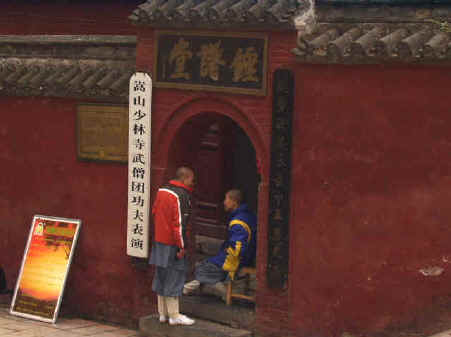
Tianwang Dian; ‘Hall of Heavenly Kings’.
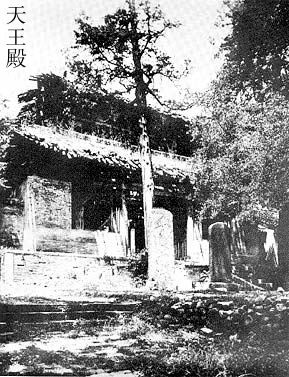 This hall was at the end of the Forest of Stelae. Behind it are the Daxiong Hall and Cangjing Ge. They add radiance and beauty to each other, and had an imposing appearance. They are often referred to as the ‘Three Great Halls’. It is a pity that these important buildings were burnt down in a fire caused by warlord Shi Yousan in 1928. Story goes that the fire lasted over 40 days; many other buildings nearby were also destroyed. This fire is said to be the most disastrous one after the Sui-to-Qing dynasties. Tianwang Dian is a Qing style structure. Its two sidedoors correspond tot the sidegates at the Entrance. Only 30 carved pillar pedestals and the stone threshold remained after the fire.
This hall was at the end of the Forest of Stelae. Behind it are the Daxiong Hall and Cangjing Ge. They add radiance and beauty to each other, and had an imposing appearance. They are often referred to as the ‘Three Great Halls’. It is a pity that these important buildings were burnt down in a fire caused by warlord Shi Yousan in 1928. Story goes that the fire lasted over 40 days; many other buildings nearby were also destroyed. This fire is said to be the most disastrous one after the Sui-to-Qing dynasties. Tianwang Dian is a Qing style structure. Its two sidedoors correspond tot the sidegates at the Entrance. Only 30 carved pillar pedestals and the stone threshold remained after the fire.
According to the pictures of the building before the fire, it was a five-room structure with double eaves. This is consistent with the pictures drawn in the book History of the Shaolin Temple and with the murals painted on the wall of the White Robe Hall.
According to the History of the Shaolin Temple, there used to be two groups of statues inside, two Vajras (Buddha’s warrior attendants) in front of the door and four Heavenly Kings guarding behind the door.
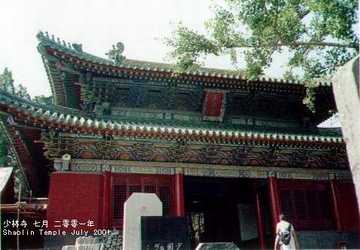 The building is now reconstructed, as are all the statues in it.
The building is now reconstructed, as are all the statues in it.
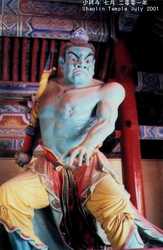
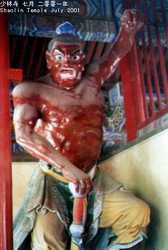 Two Vajras (Buddha’s warrior attendants)
Two Vajras (Buddha’s warrior attendants)
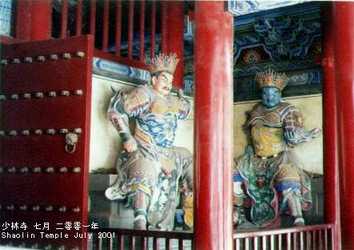
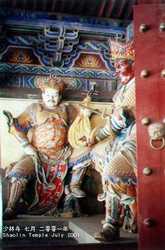 The four Heavenly Kings were gods in an ancient Indian myth, which said that in the midst of Mount Sumeru (considered to be the central point of the human world), the four Heavenly Kings were guarding the first of a series of six skies. Buddhism adopts this myth by asserting the the four gods were four heavenly guardians, each in charge of one quarter of the world. They were respectively called Chiguo (State Guardian) in the east (dressed in white and holding a pipa) Guangmu (Sharp seer) in the west (dressed in red, a silk rope in his hand, Zhengzhang (Growth protector) in the south (dressed in black, holding a sword) and Duowen (Knowledge preserver) in the north (dressed in green holding a stone pillar).
The four Heavenly Kings were gods in an ancient Indian myth, which said that in the midst of Mount Sumeru (considered to be the central point of the human world), the four Heavenly Kings were guarding the first of a series of six skies. Buddhism adopts this myth by asserting the the four gods were four heavenly guardians, each in charge of one quarter of the world. They were respectively called Chiguo (State Guardian) in the east (dressed in white and holding a pipa) Guangmu (Sharp seer) in the west (dressed in red, a silk rope in his hand, Zhengzhang (Growth protector) in the south (dressed in black, holding a sword) and Duowen (Knowledge preserver) in the north (dressed in green holding a stone pillar).
 In the early Qing Dynasty a sign board was hung on the outer wall with six chinese characters meaning ‘Genuine Birthplace of Buddhism’. Another board with characters, Shao Lin Si (Shaolin temple), written by Emperor Kang Xi, was put up in 1704. It is now above the Entrance of the temple.
In the early Qing Dynasty a sign board was hung on the outer wall with six chinese characters meaning ‘Genuine Birthplace of Buddhism’. Another board with characters, Shao Lin Si (Shaolin temple), written by Emperor Kang Xi, was put up in 1704. It is now above the Entrance of the temple.
Taizong Wenhuangdi Yushubei:Three Religions and Nine Schools
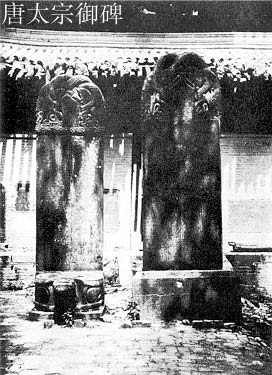 Memorial stone written by Emperor Taizong & Hunyuan San Jian Jiu Liu Tuzan Beike; Three Religions and Nine Schools
Memorial stone written by Emperor Taizong & Hunyuan San Jian Jiu Liu Tuzan Beike; Three Religions and Nine Schools
In the history of Shaolin temple, Tang Dynasty was important for its development and prosperity. It was a period monks of ages were proud of. In fact, the fate of the Shaolin temple was closely bound with that of the Tang Dynasty. The supreme leaders showed special concern for the temple, regarding it as an important center of Buddhism, and often paid visits to it. The unusually intimate relationship between the imperial court and the temple originated from the historical fact that, at the time Li Yuan (the first Tang emperor) and Li Shimin (son of Li Yuan) founded the Tang Dynasty, they had great support from the monks in the was against Wang Shichong (a local despot belonging to the defeated Sui Dynasty crown). The grants by the Tang emperors played an important role in the consolidation and development of the temple.
The story of Li Shimin and the Shaolin temple goes as follows:
In May 614 the Sui Dynasty ended and Emperor Yang You made room for Li Yuan and the Tang period started. But there were still people who wanted to restore the Sui. One of these attempts to took place in the vicinity of the temple and the monks of the temple turned out to be a decisive factor.
Former garrison commander of nearby Luoyang, Yuan Wendu cooperated with general Wang Schichong to overthrow the newborn Tang. In April the year after founding the Tang the new Emperor Yua Wangtong was dethroned and Wang Shichong made himself emperor instead and founded a new country which he called ‘Zheng’. The new ‘emperor’ send troops to Luoyang and Songshan Mountain to secure the area. The manor of Baiguwu, which was given to the Shaolin temple during the Sui dynasty, was also occupied. This place was of strategic importance. From Baiguwu Wang Shichong led his forces against the troops of the Tang dynasty. Tang prince Li Shimin send his troops, after winning battles with Song Jingang and Liu Wuzhou and having concurred the area’s of Mingzhou, Bingzhou and Xiaxian, to Wang Shichong to fight him. By the time Wang had the Songshan-Luoyang district under control and also ruled over Yinzhou, Dengzhou and several other cities. On top of that Tian Zan, a military officer of the Tang, defected to Wang, which further contributed to his military strength. In April 621 Prince Li Yuanji fought Wang Shichong, but was defeated. At this critical moment, Zhi Cao, head priest of Shaolin temple, leading armed monks, appeared suddenly at the mountain pass and gave Wang a surprise attack from the rear, which threw Wang’s army into confusion at one blow. In the battle, Wang Renze, nephew of Wang Shichong was captured alive and sent to the Tang camp. This military operation offered great support and encouragement to the army of the Tang Dynasty.
In his edict to the Shaolin temple, Li Shimin (then named Emperor Taizong) highly cited the monks for their meritorious deeds in the battle. He granted audience to the leading monks (during the fights 13 monks stood out, amongst them were; Jin Cao, Hui Yong and Tan Zong) and awarded them. The Emperor wanted to award them personally, but they refused. Only the leader (should be Zhi Cao) received the military title of Da Jiangjun (regent/regent-marshal/supreme commander).
Later the temple was endowed 40 qing (267 ha) of land. It is also said he gave the temple official permission to train a small army of martial monks. On top of that he send a gift of wine and meat and gave them permission to eat meat and drink alcohol.
Since that time the monks of the Shaolin temple drink alcohol and eat meat. Because of this, many traditional Buddhists don’t like the Shaolin temple.
 In 728 was a tablet was erected, which told the events. The text was once dictated by emperor Taizong during his visit to the temple. This visit took place on the 30th day of the 4th lunar month in the 4th year since the commencement of the Tang Dynasty (621). The text was engraved on the upper part of the front side of the tablet. The words were written in 38 lines, each of 8 Chinese characters. In the fifth line there is the name “Shimin” autographed by Li Shimin himself. The text praised the monks who helped him in defeating Wang Shichong. Under the text are carved the name of the tablet Shaolin Temple of the Imperial Tang, written by Pei Cui. The inscription that follows describes the historical events relating to the Temple from its initial stage to the reign on Emperor Xuan Zong (712-742). On the back of this tablet is carved the Inscription about the Imperial Bestowal on Shaolin Temple autographed by Emperor Li Shimin. The meaning is basically the same as that on the front side. Below it are the imperial documents concerning Shaolin temple promulgated respectively in 621,625,632 an 723. The tablet can still be seen near the Bell tower of the temple.
In 728 was a tablet was erected, which told the events. The text was once dictated by emperor Taizong during his visit to the temple. This visit took place on the 30th day of the 4th lunar month in the 4th year since the commencement of the Tang Dynasty (621). The text was engraved on the upper part of the front side of the tablet. The words were written in 38 lines, each of 8 Chinese characters. In the fifth line there is the name “Shimin” autographed by Li Shimin himself. The text praised the monks who helped him in defeating Wang Shichong. Under the text are carved the name of the tablet Shaolin Temple of the Imperial Tang, written by Pei Cui. The inscription that follows describes the historical events relating to the Temple from its initial stage to the reign on Emperor Xuan Zong (712-742). On the back of this tablet is carved the Inscription about the Imperial Bestowal on Shaolin Temple autographed by Emperor Li Shimin. The meaning is basically the same as that on the front side. Below it are the imperial documents concerning Shaolin temple promulgated respectively in 621,625,632 an 723. The tablet can still be seen near the Bell tower of the temple.
Of the fights a mural was also made, this can be seen inside the White Robe Hall (Baiyi Dian). (See the picture at the beginning of this section)
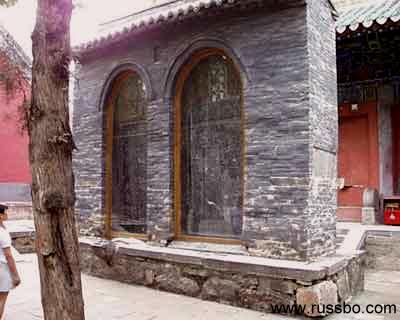
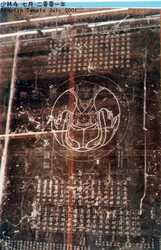 Three Religions and Nine Schools
Three Religions and Nine Schools
Zhong Lou; ‘Bell Tower’
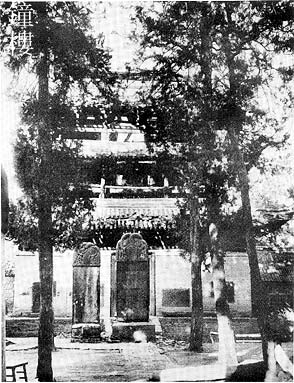
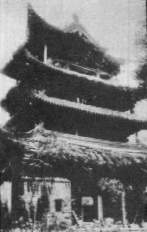 The Bell Tower was one of the tallest buildings in the temple. From the picture on the back of the tablet Deeds of Dharmapala, the wall paintings in White Robe Hall and pictures taken before it was destroyed by fire, the Bell Tower was pavilion style structure, approximately 9×15 in size, four layers of flying eaves. It measured 10 zhang (more than 33 meters) in height and looked very lofty.
The Bell Tower was one of the tallest buildings in the temple. From the picture on the back of the tablet Deeds of Dharmapala, the wall paintings in White Robe Hall and pictures taken before it was destroyed by fire, the Bell Tower was pavilion style structure, approximately 9×15 in size, four layers of flying eaves. It measured 10 zhang (more than 33 meters) in height and looked very lofty.
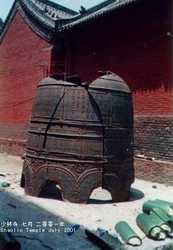 The iron bell hanging in the top room of the tower crashed down to the ground when the tower was burnt. It now rests next to the newly build Bell Tower. The inscriptions on the bell say that it was cast in 1204. The bell in 200cm high, 170cm in calibre and its wall in 4 to 12cm thick from top to bottom. The bell weights 5500kg. There are eight lips along the edge (for striking). The Eight Diagrams cast on the bell indicate the hanging positions. According to the History of the Shaolin Temple the bell could be heard 30 li (15 km) away.
The iron bell hanging in the top room of the tower crashed down to the ground when the tower was burnt. It now rests next to the newly build Bell Tower. The inscriptions on the bell say that it was cast in 1204. The bell in 200cm high, 170cm in calibre and its wall in 4 to 12cm thick from top to bottom. The bell weights 5500kg. There are eight lips along the edge (for striking). The Eight Diagrams cast on the bell indicate the hanging positions. According to the History of the Shaolin Temple the bell could be heard 30 li (15 km) away.
There are two other relics on the ruins of the Bell Tower. One is the statue of Ksitigarba cast in 148, 175cm high. He is bald headed, sitting with his legs crossing in the lotus-shaped pedestal, his kasaya over his shoulders: but his chest is not covered. The other is a tablet named Inscription on the Casting of the Copper Statue of Maitreya, standing in the northwest corner. It is 138cm high, 61cm wide and 17.5cm thick, cast in the same year as the statue of Ksitigarba.
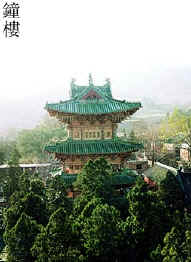 Present day information board attached to the building says this:
Present day information board attached to the building says this:
“The Bell Tower is a spacious pavilion – style structure at the foot of the mountain, with four layers of flying eaves. It is one of the major building in the temple, more than 33 meters high. The original building was destroyed in 1928 and was rebuilt in 1994 after the old model. The bell hanging in the tower weighs about 6500 kg. The statue of Bodhissattva Dizang (Ksitigarbha) was cast in the first year of Emperor Hongzhi of the Ming Dynasty. It is 1.7 meters tall, weighing more than 5000 kg.”
 In 728 was a tablet was erected, which told the events of monks saving Lishimin. The tablet can be found at the foot of the Bell Tower. The picture on the left shows the tablets protected by a brick structure. The first B/W picture on this page shows the tablets freestanding.
In 728 was a tablet was erected, which told the events of monks saving Lishimin. The tablet can be found at the foot of the Bell Tower. The picture on the left shows the tablets protected by a brick structure. The first B/W picture on this page shows the tablets freestanding.
The text was once dictated by emperor Taizong during his visit to the temple. This visit took place on the 30th day of the 4th lunar month in the 4th year since the commencement of the Tang Dynasty (621). The text was engraved on the upper part of the front side of the tablet. The words were written in 38 lines, each of 8 Chinese characters. In the fifth line there is the name “Shimin” autographed by Li Shimin himself. The text praised the monks who helped him in defeating Wang Shichong. Under the text are carved the name of the tablet Shaolin Temple of the Imperial Tang, written by Pei Cui. The inscription that follows describes the historical events relating to the Temple from its initial stage to the reign on Emperor Xuan Zong (712-742). On the back of this tablet is carved the Inscription about the Imperial Bestowal on Shaolin Temple autographed by Emperor Li Shimin. The meaning is basically the same as that on the front side. Below it are the imperial documents concerning Shaolin temple promulgated respectively in 621,625,632 an 723. Of the fights a mural was also made, this can be seen inside the White Robe Hall (Baiyi Dian).
Gu Lou; ‘Drum Tower’
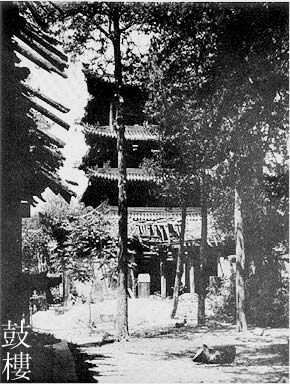 The Drum Tower is situated to the north west of the Tianwang Hall, opposite to the Bell Tower. It was first built in 1300 ( in the reign of Emperor Cheng Zong of the Yuan Dynasty) After the fire only the broken carved stone columns, carved pedestals and the stone threshold remained. According to records of the ancient tablets, the murals and especially the pictures of the building before it was destroyed, the shape and dimensions of this tower were quite large and magnificent.
The Drum Tower is situated to the north west of the Tianwang Hall, opposite to the Bell Tower. It was first built in 1300 ( in the reign of Emperor Cheng Zong of the Yuan Dynasty) After the fire only the broken carved stone columns, carved pedestals and the stone threshold remained. According to records of the ancient tablets, the murals and especially the pictures of the building before it was destroyed, the shape and dimensions of this tower were quite large and magnificent.
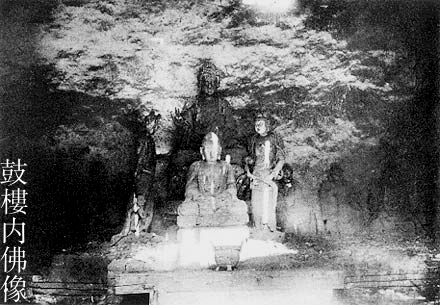 Image of Buddha inside the Drum Tower.
Image of Buddha inside the Drum Tower.
Between the Bell Tower and the Drum tower there are five tablets standing in one line:
1. Inscription on Repairing Shaolin Temple, by Yang Guozhen in 1829;
2. Inscription on Renovating 1000 Buddha Hall, by Zneg Youreng in 1776;
3. Poem Tablet; Ode to Songshan Mountain & Shaolin, by Wang Shangjong, Ming Dynasty;
4. Damo Ferrying the Changjiang (Yangtze) River by Reed & devil subduing deity Zong Kui, illustration, by Lang Jianting in 1624.
5. Imperial book about the Genealogy of Five Schools of Chan Sect Buddhism.
It is a genealogical table of Buddhism successors in Shaolin temple since Damo. This tablet is very important for the study of the history of Shaolin temple.
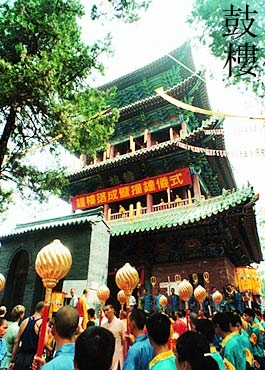 Present day (2001) information board attached to the building says this:
Present day (2001) information board attached to the building says this:
“The Drum Tower was a building of the Yuan Dynasty. It was destroyed in 1928 and was rebuilt in 1996 after the old model. I is a magnificent and spacious pavilion – style structure at the foot of the mountain, with a height of more than 33 metres. Inside the tower is stored China’s biggest handicraft drum. The Drum Tower is just opposite to the Bell Tower. When both the drum and bell are sounding simultaneously, they can be heard as far as more than 30 li away.”
Jinnaluo Tang; Kimnara Hall
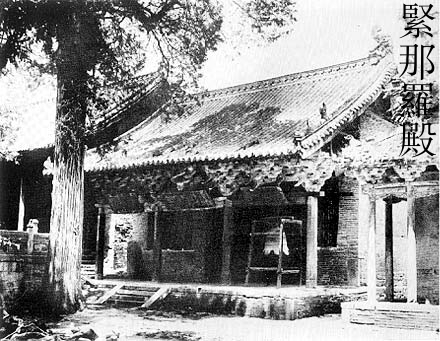 This hall is situated to the east of Ducting Hall, north of the Bell Tower. It used to be a three-room structure. Three statues of Jin Na Luo ((Kimnara) were once consecrated in it.
This hall is situated to the east of Ducting Hall, north of the Bell Tower. It used to be a three-room structure. Three statues of Jin Na Luo ((Kimnara) were once consecrated in it.
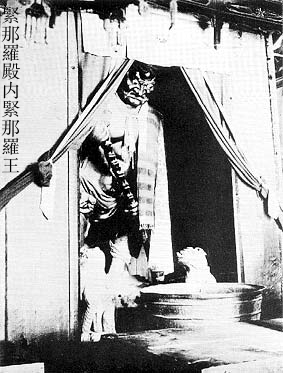 The one in the middle was a rattan statue; the left one was cast of copper, and the right one of iron. They were all wonderfully shaped. Kimnara was regarded as one of the protecting deities of the temple; and according to the Buddhist doctrine, he is also one of the eight deties protecting Buddhism.
The one in the middle was a rattan statue; the left one was cast of copper, and the right one of iron. They were all wonderfully shaped. Kimnara was regarded as one of the protecting deities of the temple; and according to the Buddhist doctrine, he is also one of the eight deties protecting Buddhism.
“Prince Kimnara, surnamed Xu, became a Buddhist monk of Shaolin in the Yuan Dynasty. After hard learning and devoted practice, he finally succeeded in becoming a Guardian Bodhissattva of Shaolin Temple. There used to be three statues of Prince Kimnara in the hall, one made of rattan, one cast in bronze and one in iron, and on both sides there used to be two stones tablets with Kinmara’s image engraved on them during the Northern Period.
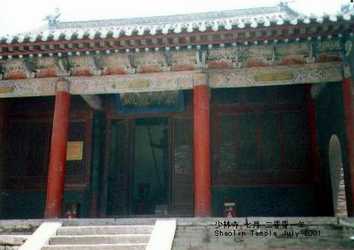
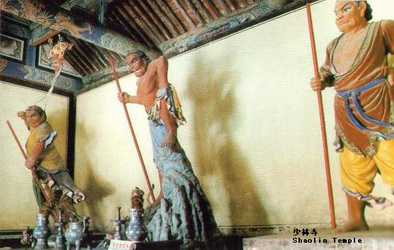
The original hall was destroyed by war in 1928. It was rebuild and repainted in 1982 after the original model. Three new statues of Prince Kimnara were recast.”
Daxiong Baodian: Daxiong Hall
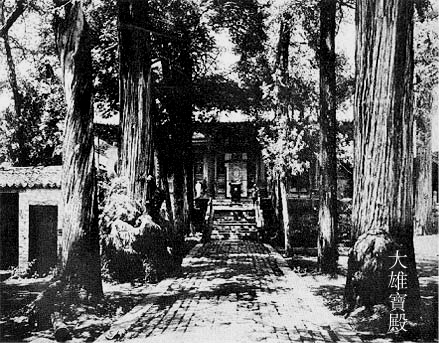 This is the centre of all buildings in the temple, where the monks do most of their services. It is often called ‘Main Hall’ or ‘Great Hall’. The hall used to be a five room building with double eaves. After the fire only the platform, the stone columns and three of the wall were among the things that remained.
This is the centre of all buildings in the temple, where the monks do most of their services. It is often called ‘Main Hall’ or ‘Great Hall’. The hall used to be a five room building with double eaves. After the fire only the platform, the stone columns and three of the wall were among the things that remained.
 Before it was destroyed, it had enshrined the statues of Sakyamuni, Amitayas (Amida Buddha) and Bhaisajyagura.
Before it was destroyed, it had enshrined the statues of Sakyamuni, Amitayas (Amida Buddha) and Bhaisajyagura.
 Against the gabled wall were laid the Buddhist boards, staffs and various weapons.
Against the gabled wall were laid the Buddhist boards, staffs and various weapons.
Inside the original Daxiong Hall before the fires of 1928.
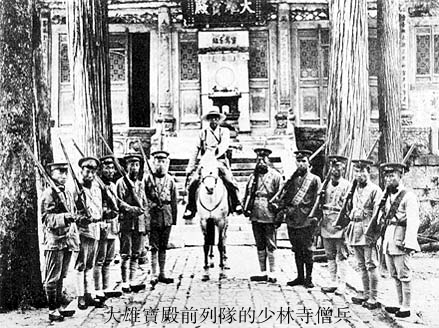
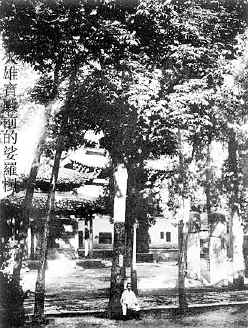
Outside the Daxiong Hall before the fires of 1928. On the left trees in front on the hall and on the right Shaolin’s army of those days.
Above the lintel inside was hung a horizontal board, on which were the words ‘Treasured Trees, Fragant Lotuses’, with the script done by Emperor Kang Xi in 1704. In each of the three middle rooms, four partition boards were arranged. The sign board, Daxiong Bedouin, was under the eaves of the middle room. The Daxiong Baodian was repaired in the Ming and Qing Dynasties. So most of the relics were the work of this period. As to the age of the hall, a sections of the brick wall and an inlaid stone inscription unearthed give the hint that it might be first build as far back as in 1169.
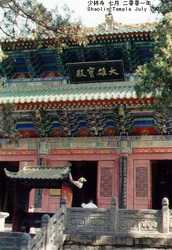 Present day (2001) information board attached to the building says this:
Present day (2001) information board attached to the building says this:
“Daxiong Hall was destroyed by war in 1928 and was rebuilt after the old model in 1985. It is a magnificent building with double eaves green glazed tile roof. Inside the hall are enshrined the statues of the three great Buddha’s and of the founder of Chanzong Bodhidharma and the guardian deity Kimnare. Besides, on the right & left side walls are enshrined the statues of the 18 Arhats covered in gold leaf. Daxiong Hall is the main place for Shaolin Buddhists to carry out their religious activities.”
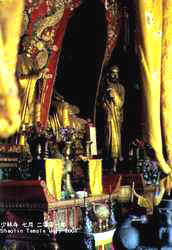
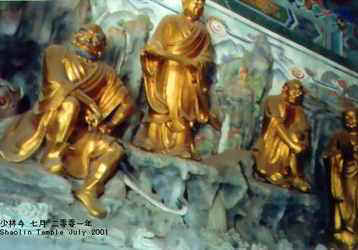 A statue of Damo next ot the main statues and some of the 18 Luohan, which are located along side the side walls
A statue of Damo next ot the main statues and some of the 18 Luohan, which are located along side the side walls
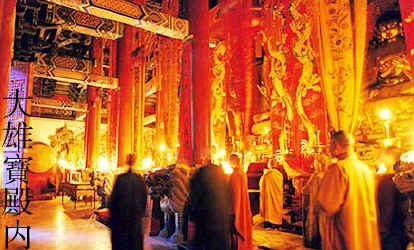
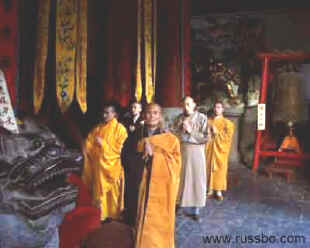
 Inside present day Daxiong Hall.
Inside present day Daxiong Hall.
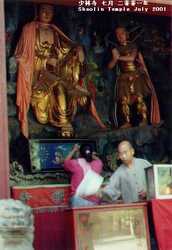 At the back of the hall a statue of Guanyin and a monk selling small jade Buddhist pendants.
At the back of the hall a statue of Guanyin and a monk selling small jade Buddhist pendants.
Cangjing Ge: Canjing Hall
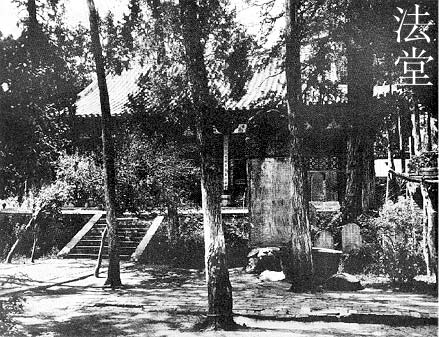 Another name for this hall is Fa Tang (Dharma Hall). It was a building for storing Buddhist scriptures and for eminent monks to preach. It was a single-eave structure with modified gable roofs, approximately 15×15 in size, first constructed in the Ming Dynasty and renovated in the Qing Dynasty.
Another name for this hall is Fa Tang (Dharma Hall). It was a building for storing Buddhist scriptures and for eminent monks to preach. It was a single-eave structure with modified gable roofs, approximately 15×15 in size, first constructed in the Ming Dynasty and renovated in the Qing Dynasty.
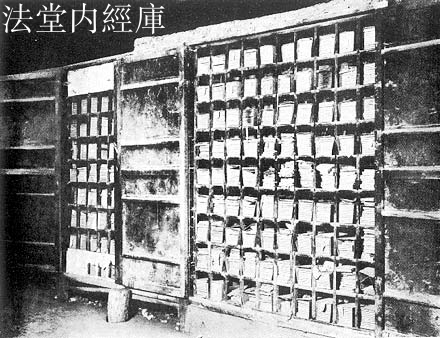 Before the fire, copper-plate Buddhist scriptures were kept in it. History of the Shaolin Temple says that “In 1743, the hall started to house Buddhist scriptures Bodhidharma’s ‘Shadow Rock’ together with illustrated books and Buddhist staffs were stored here.
Before the fire, copper-plate Buddhist scriptures were kept in it. History of the Shaolin Temple says that “In 1743, the hall started to house Buddhist scriptures Bodhidharma’s ‘Shadow Rock’ together with illustrated books and Buddhist staffs were stored here.
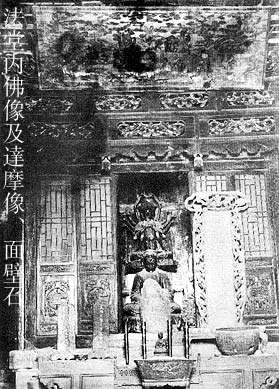 Inside the Dharma Hall was kept a statue of Damo.
Inside the Dharma Hall was kept a statue of Damo.
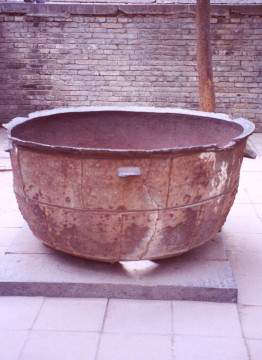 On the east side of the path in front of the hall there is a large iron caldron 167cm in diameter and 84 centimeters deep, its wall being 2cm in thickness. On its 7-centimeter rim are words showing that the caldron was cast in November 1577 and its weight was 1300 jin (650 kg). It has five ears on the outside wall. Opposite the caldron, a large millstone is put on the west side of the path, the upper stone bearing the words ‘made in 1565’.
On the east side of the path in front of the hall there is a large iron caldron 167cm in diameter and 84 centimeters deep, its wall being 2cm in thickness. On its 7-centimeter rim are words showing that the caldron was cast in November 1577 and its weight was 1300 jin (650 kg). It has five ears on the outside wall. Opposite the caldron, a large millstone is put on the west side of the path, the upper stone bearing the words ‘made in 1565’.
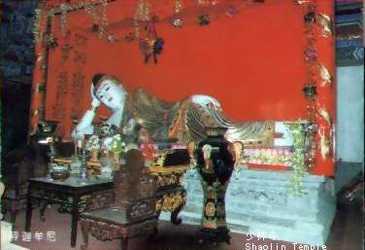 ‘Cangjing Hall, also named Dharma Hall, was a building for keeping Buddhist scriptures and for preaching Buddhist doctrines. It was built during the Ming Dynasty but was destroyed in 1928. In 1992 Governor Li Changchun of the People’s Government of Henan Province appropriated one million RMB yuan for the rebuilding of this hall. The white jade figure of Buddha enshrined inside the Dharma Hall was presented by eminent monk Yang Guangfo of Burma.’
‘Cangjing Hall, also named Dharma Hall, was a building for keeping Buddhist scriptures and for preaching Buddhist doctrines. It was built during the Ming Dynasty but was destroyed in 1928. In 1992 Governor Li Changchun of the People’s Government of Henan Province appropriated one million RMB yuan for the rebuilding of this hall. The white jade figure of Buddha enshrined inside the Dharma Hall was presented by eminent monk Yang Guangfo of Burma.’
Liu Zu Tang; Six Saints Hall
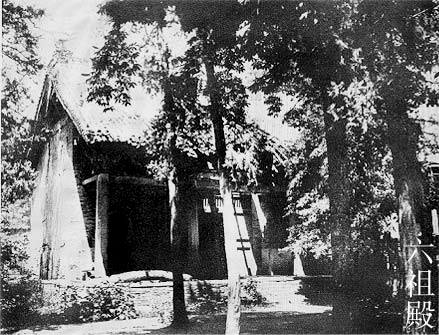 This hall was rebuilt on its original site opposite to Kimnara Hall. It is also a three-room building.
This hall was rebuilt on its original site opposite to Kimnara Hall. It is also a three-room building.
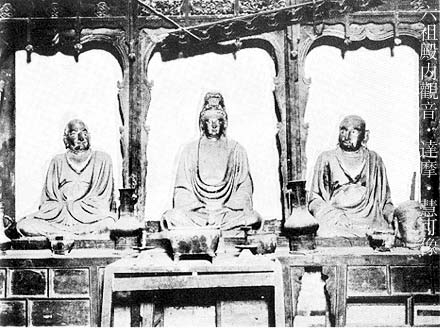 Formerly, figures of Shaolin Saints Bodhidharma, Hui Ke, Seng Jie, Dao Xin, Hong Ren and Hui Neng were cast around the statue of Avolakitesvara, a famous Boddhisattva. Such was Six Saints at an Audience with Avolokitesvara in the hall burnt in 1928.
Formerly, figures of Shaolin Saints Bodhidharma, Hui Ke, Seng Jie, Dao Xin, Hong Ren and Hui Neng were cast around the statue of Avolakitesvara, a famous Boddhisattva. Such was Six Saints at an Audience with Avolokitesvara in the hall burnt in 1928.
Besides, there used to be 29 portraits of famous Shaolin monks on the wall. None of these are now in existence.
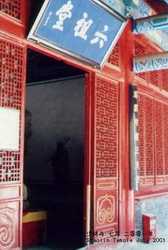 “In the original hall, there used to be a group of statues on the shrine showing the “Six Saints Paying Homage to Bodhisvattva Guanyin, with the Master Buddhists in various generations painted on the side walls. The original hall was destroyed by war in 1928 and was rebuilt and repainted in 1982 after the old model.
“In the original hall, there used to be a group of statues on the shrine showing the “Six Saints Paying Homage to Bodhisvattva Guanyin, with the Master Buddhists in various generations painted on the side walls. The original hall was destroyed by war in 1928 and was rebuilt and repainted in 1982 after the old model.
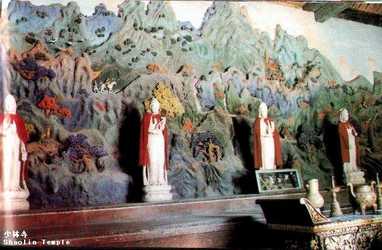 Now inside the hall are enshrined white Jade statues of five Bodhisattvas: Guanyin (Avalokitesvara), Wenshu, Puxian, Dizang, Dashizhi.
Now inside the hall are enshrined white Jade statues of five Bodhisattvas: Guanyin (Avalokitesvara), Wenshu, Puxian, Dizang, Dashizhi.
At both sides are enshrined colour clay images of the founder of Chanzong, and the second, the third, the fifth, and the sith generation Master Monks of Chanzong. On the side wall is the relief sculpture showing how Dhama crossed a river by means of a single reed leaf.”
Fangzhang; Abbot’s Room
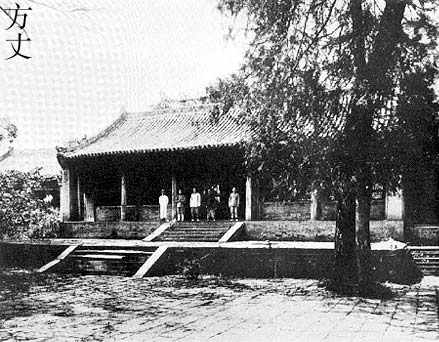 The Abbots Room is to the north of Dharma Hall. In 1750, when visiting Mount Song, Emperor Gao Zong of Qing Dynasty visited the temple he lodged in this room. After that the room was also known as the Dragon hall, since the dragon is the symbol of the emperor.
The Abbots Room is to the north of Dharma Hall. In 1750, when visiting Mount Song, Emperor Gao Zong of Qing Dynasty visited the temple he lodged in this room. After that the room was also known as the Dragon hall, since the dragon is the symbol of the emperor.
An iron bell cast in 1336 and weighing 325 kg, is hanging on the east end of the front eve, on which the names of Abbot Xi An and a Japanese monk, Shoogen, are cut. Since Shoogen worked in this temple as a secretary, he was often called Secretary Shoogen.To the west of the Abbot’s Room is a lounge where the elder abbots can rest; and to the east is another house built in the Ming Dynasty, originally called Kuo Ran Tang (Quit Hall). It has gone through quite a number of repairs and is now called Jing Zhong Jing (More Quiet Than Quiet). The wing rooms are monk’s dwelling places. Opposite the Abbot’s Room there used to be an carved arch built in the Qing Dynasty. It was the last building destroyed by the fire in 1928.
In the south-room walls of the Abbot’s Yard are inlaid more than 20 pieces of stone engraved images and poems left by visitors. Tablets with images of Hui Ke, Damo with one show, poems about Hui Ke, inscriptions and an eulogy of Guanyin.
 “The Abbot’s Room is the place where the aboot lives and executes his daily affairs. It was built during the reign of Emperor Qianlong of the Qing Dynasty (1750). In September when Emperor Gao Zong of the Qing Dynasty paid a visit to this room, he lodged in this very room. That is way this room is also called ‘Long Ting’ (The Dragon Hall). The bronze statue of Dhama enshrined inside is was presented by monks from Japan’s Shaolin Temple.”
“The Abbot’s Room is the place where the aboot lives and executes his daily affairs. It was built during the reign of Emperor Qianlong of the Qing Dynasty (1750). In September when Emperor Gao Zong of the Qing Dynasty paid a visit to this room, he lodged in this very room. That is way this room is also called ‘Long Ting’ (The Dragon Hall). The bronze statue of Dhama enshrined inside is was presented by monks from Japan’s Shaolin Temple.”
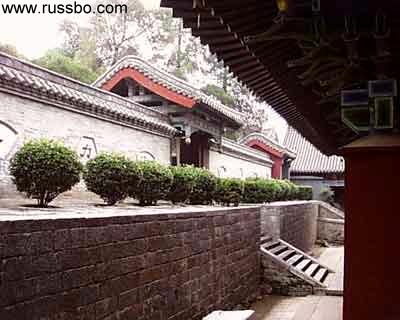
Lixue Ting: Standing in Snow Pavilion
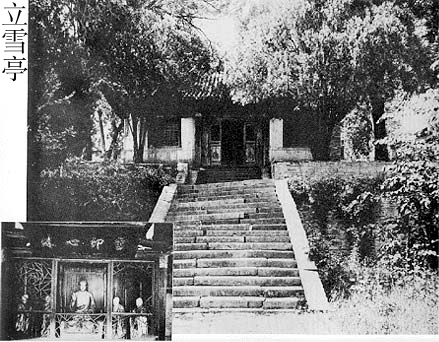 It is also named the Dharma Bower. The bower is said to be the site where the second saint Shen Guang stood in deep snow waiting for Damo’s consent to teach him.
It is also named the Dharma Bower. The bower is said to be the site where the second saint Shen Guang stood in deep snow waiting for Damo’s consent to teach him.
This bower is a small exquisite building with single eaves, built in the Qing Dynasty. On the carved columns under the eaves, inscriptions were made.
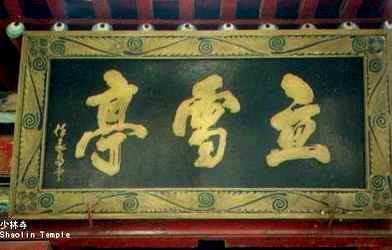
Li Xue Ting
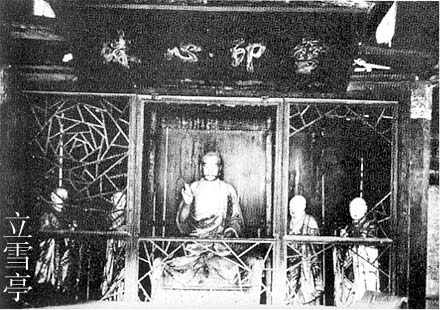 A statue of Damo in sitting posture is consecrated in the shrine in the building. Above the shrine is a board on which four Chinese characters Xue Yin Xin Zhu (Deepest Piety Imprinting Snow) are inscribed ; the script was done by Emperor Qian Long of the Qing Dynasty. Now the bower is used by monks to perform religious services. A copper bell casst 1589, a drum and a alms bowl are preserved in it. The outer face of the east have several important tablets inlaid in it. Image of Guanyin 99 x 45 cm in size, made in Jin Dynasty. On the upper part of the tablet is an eulogy of Guanyin composed by Su Shi a very famous poet of the Song Dynasty. The eulogy was done in (in February 1192) in the handwriting of Lu Ming and was carved by Shou Bian.
A statue of Damo in sitting posture is consecrated in the shrine in the building. Above the shrine is a board on which four Chinese characters Xue Yin Xin Zhu (Deepest Piety Imprinting Snow) are inscribed ; the script was done by Emperor Qian Long of the Qing Dynasty. Now the bower is used by monks to perform religious services. A copper bell casst 1589, a drum and a alms bowl are preserved in it. The outer face of the east have several important tablets inlaid in it. Image of Guanyin 99 x 45 cm in size, made in Jin Dynasty. On the upper part of the tablet is an eulogy of Guanyin composed by Su Shi a very famous poet of the Song Dynasty. The eulogy was done in (in February 1192) in the handwriting of Lu Ming and was carved by Shou Bian.
The image of Guanyin on the lower part is 60 centimeters high. She is standing on two lotus flowers and holding a string of beads, composed and completely free of care.Het dress is very neat and splendid. This picture, fine for its craft, is one of the best line drawings in the temple. Drawn by Zu Shao in 1209. Image of the Second Saint, made in 1221. On the upper right hand corner of the tablet is carved a verse, describing how Hui Ke showed Damo his loyalty to Buddhism. This tablet is 67x62cm in size.
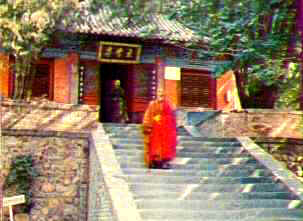
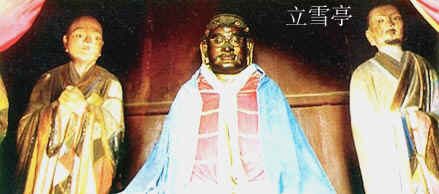
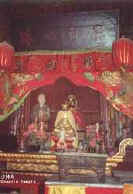 Present day statue of Damo.
Present day statue of Damo.
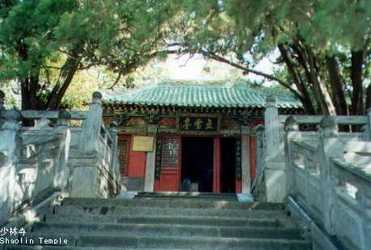 “Lixue Pavilion (Stadning-in-the-Snow Pavilion), also named Dhama Pavilion, was built in the Qing Dynasty. This pavilion is the birthplace of Chinese Chanzong. It is believed to be the vey place were the second-generation Master Monk Huike, in order to learn the essence of Chanzong and receive the kayasa and alms bowl from Dhama, stood deep in snow and cut off his own left arm. Above the shrine, there hangs a board bearing four Chinese Characters ‘Xue Yin Xin Zhu’.
“Lixue Pavilion (Stadning-in-the-Snow Pavilion), also named Dhama Pavilion, was built in the Qing Dynasty. This pavilion is the birthplace of Chinese Chanzong. It is believed to be the vey place were the second-generation Master Monk Huike, in order to learn the essence of Chanzong and receive the kayasa and alms bowl from Dhama, stood deep in snow and cut off his own left arm. Above the shrine, there hangs a board bearing four Chinese Characters ‘Xue Yin Xin Zhu’.
Dizang Dian: Ksitigarbha Hall
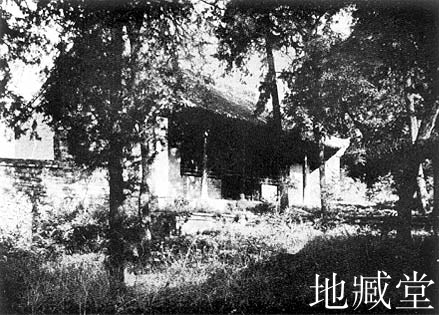 Di Zang (Ksitigarbha) Hall, standing to the west of the 1000 Buddha Hall’, used to be in the Qing architectural style. It was repaired more than 20 years ago. In the shrine, statues of Bodhisvattva Ksitigarbha and his two attendants (flanking him) were cast. There were murals on the walls, which peeled of long ago.
Di Zang (Ksitigarbha) Hall, standing to the west of the 1000 Buddha Hall’, used to be in the Qing architectural style. It was repaired more than 20 years ago. In the shrine, statues of Bodhisvattva Ksitigarbha and his two attendants (flanking him) were cast. There were murals on the walls, which peeled of long ago.
“Dizang (Ksitigarbha) Hall was a building of the Qing Dynasty. It was renovated in 1979 after the old model. Inside the hall a statue of Bodhisattva Ksitigarbha is enshrined, with his two attendants Dao Ming and Min Hua flanking him. Because Bodhisattva Ksitigarbha once said, “I will never become a Buddha until the Hell is emptied”, he is renowned as “the Truly Magnanimous”. On the north and south walls is are mounted pictures of the Ten Princes of Hades and on the back wall a mural is painted of the Twenty-four Filial Persons in the Confucian tradition.”
Talin Yuan; Pagoda yard.
Pagoda Yard takes its position in the central west of the monastery. According to record, a pagoda yard was set in Shaoln temple no later than the Sui Dynasty. It was repaired during the Tand and Song Dynasties. Today there are still ancient pagodas standing in the west and east parts of the yard, not far apart from each other. Both were build in 1088 by Guang Qing, a shaolin monk. The Buddhist pagoda in the west stands on a two layer base in the northwest corner of the yard. It has a rerely seen rectangular plane retangle, 415 centimeters wide and 318 centimeters long. It is double eave pagoda, and both the upper and lower stories are monastic rooms. In the lower stoty, there is a stone statue of Maitreya, 173 centimeters high, carved in the Tang Dynasty. He is standing on lotus flowers, calm and confident, his posture sedate. The pleats of his clothes suggest that they may have come out from water but never get wet or spoiled by it. This stone statue is one of the most valuable ones among all the figures of Buddha in Shaolin temple. The inscription on a stone tablet in the west wall of the pagoda describes how it once survived the ‘Abolotion of Buddhism’ by the Tang Dynasty ruler Wu Zong (Li Yan) who reigned between 841-847. Maitreya Pagoda is 8 meters away. It is a brick structure, square in shape, with ten overlapping eaves all in simple close style. The statue inside was made later. According to Shi Lao Zhi (Biography of Sakyamuni), Sakyamuni one said that Maitreya came to this world as the second greatest Buddha. Up to now, above the pagoda door, six words meaning ‘ Pagoda in memory of Meitreya’s decendance still remain. The character tablet inlaid the west wall is 33cm high anD 77cm wide. There are also a few tablets of Ming and Qing Dynasties on each side of the pah in front of the pagoda.
Guanyin Dian; White Robe Hall
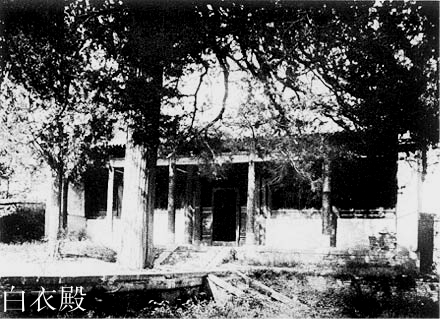 The White Robe Hall to the east of The ‘1000 Buddha Hall’, with its overhanging gable roofs, was built in the Qing Dynasty. There are murals inside the hall showing pugilistic developments of Shaolin Boxing, for which it is also known as Quan Pu Dian (Pugilist Hall). Scenes of monks in their martial arts practice are presented on the north and south walls of the hall.
The White Robe Hall to the east of The ‘1000 Buddha Hall’, with its overhanging gable roofs, was built in the Qing Dynasty. There are murals inside the hall showing pugilistic developments of Shaolin Boxing, for which it is also known as Quan Pu Dian (Pugilist Hall). Scenes of monks in their martial arts practice are presented on the north and south walls of the hall.
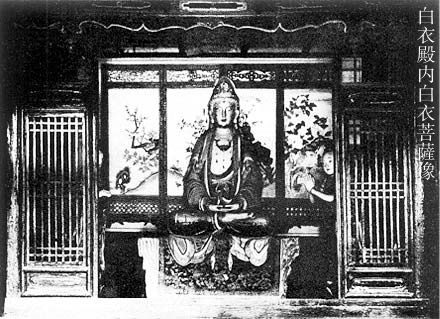 A bronze statue of White Robe Bodhisvattva stands in the shrine inside the hall.
A bronze statue of White Robe Bodhisvattva stands in the shrine inside the hall.
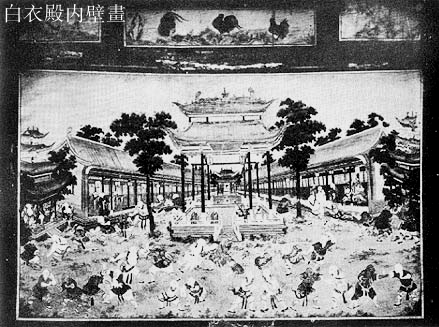 On the north wall there are 16 groups of monks fighting barehanded. In one group a well trained boxer monk (known as Zhan Ju legendarily) is sparring with three other monks, one of whom has been struck down on the ground, while the others can do nothing but parry his constantly blows. These drawings are a vivid representation of Shaolin Boxing of ancient times. In addition, the bell tower, drum tower, the main hall and its wing houses in the mural are all primarily in conformity with the construction plots of present day Shaolin temple and its ruins. Only the painters have rendered each of the buildings in the style of pavilions by means of perspective, in order to bring the temple into sight.
On the north wall there are 16 groups of monks fighting barehanded. In one group a well trained boxer monk (known as Zhan Ju legendarily) is sparring with three other monks, one of whom has been struck down on the ground, while the others can do nothing but parry his constantly blows. These drawings are a vivid representation of Shaolin Boxing of ancient times. In addition, the bell tower, drum tower, the main hall and its wing houses in the mural are all primarily in conformity with the construction plots of present day Shaolin temple and its ruins. Only the painters have rendered each of the buildings in the style of pavilions by means of perspective, in order to bring the temple into sight.
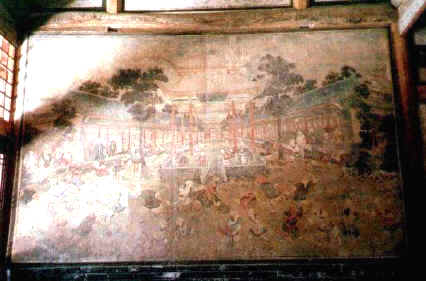 The mural anno 2001: compare the state it is in with the B/W picture, which was taken about 85 before that.
The mural anno 2001: compare the state it is in with the B/W picture, which was taken about 85 before that.
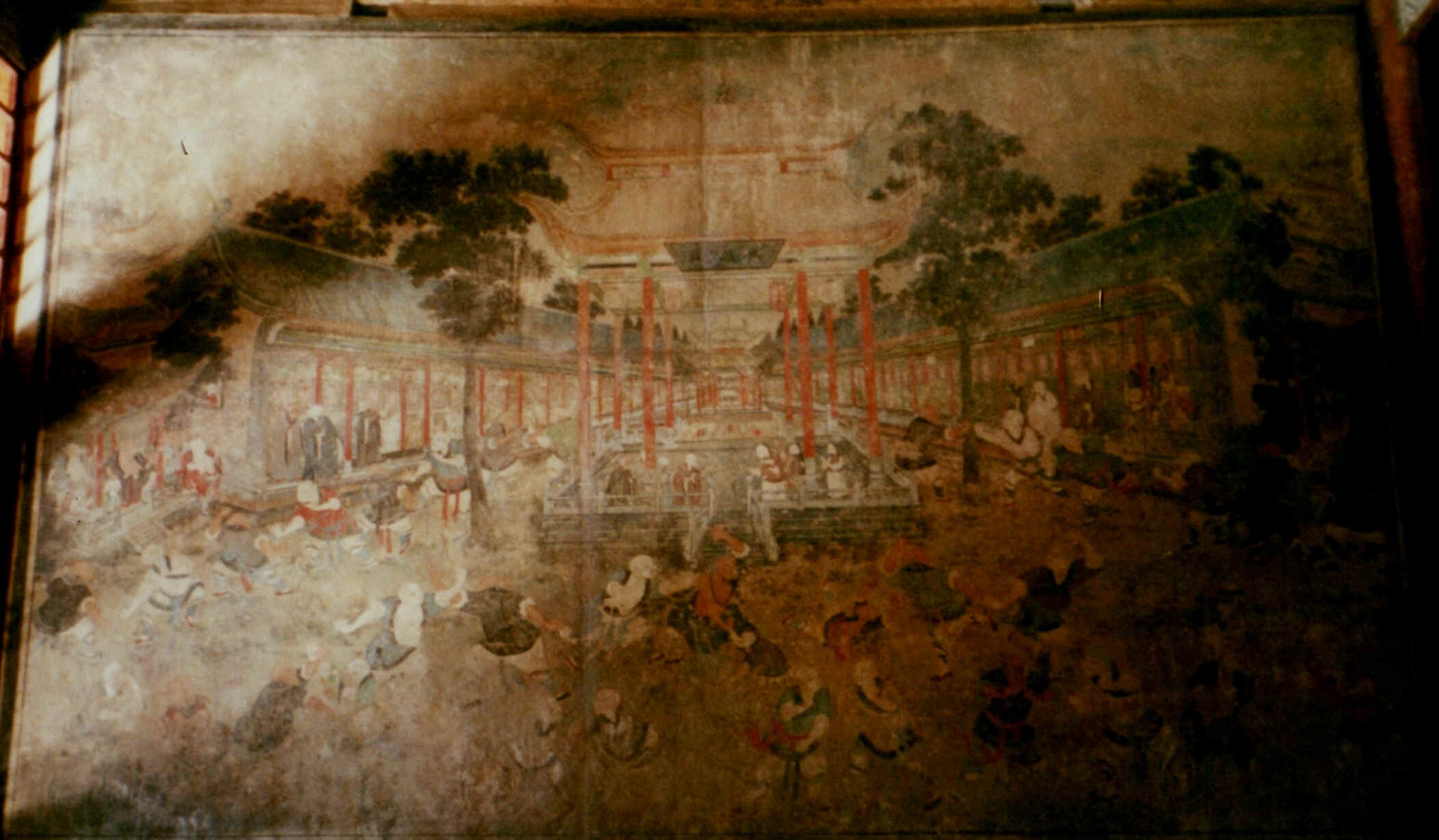
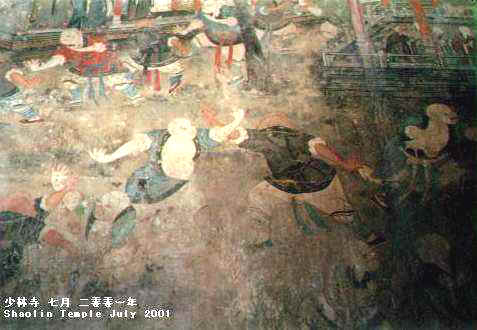 Detail.
Detail.
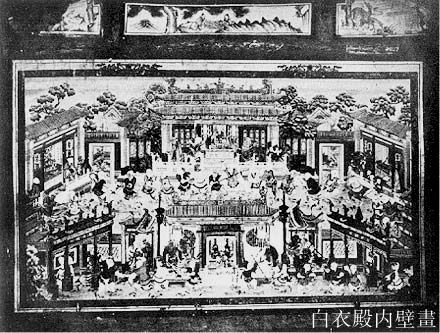 On the opposite wall, scenes of armed martial practice are painted in 15 groups. The weapons include cudgels, spears, daggers, swords, halberds, bladed double rings etc.
On the opposite wall, scenes of armed martial practice are painted in 15 groups. The weapons include cudgels, spears, daggers, swords, halberds, bladed double rings etc.
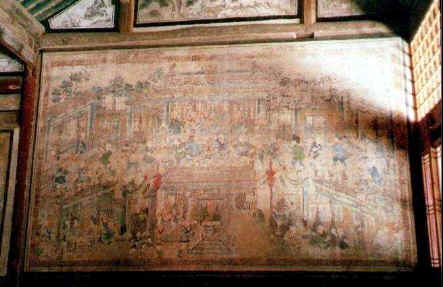 The mural anno 2001: compare the state it is in with the B/W picture, which was taken about 85 before that.
The mural anno 2001: compare the state it is in with the B/W picture, which was taken about 85 before that.
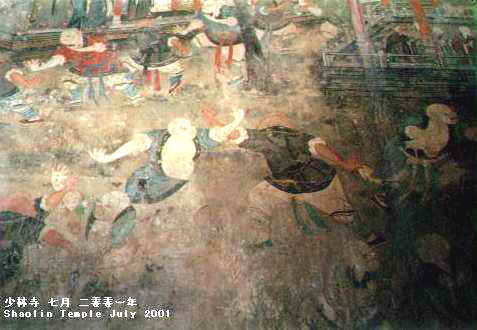 Detail
Detail
On the back wall, the picture is divided into four parts:
The northern part tells the story of Shaolin monks Zhi Cao, Tan Zong and eleven others rescuing Prince Li Shimin in the early Tang Dynasty; the southern part is the scene in which a stoker of the temple made his powerful presence felt and scared the uprising peasants away. These two pictures give show the clear political inclination of the Shaolin monks in ancient time.
In the east part of the south and north end walls are respectively painted the images of Wenshu (Bodhisvattva Manjusri) and Puxian (Bodhisvattva Samantabhadra). The workmanship, little short of gongbi (traditional Chinese realistic painting characterized by fine brushwork and close attention to details), is much more exquisite than the first four pictures.
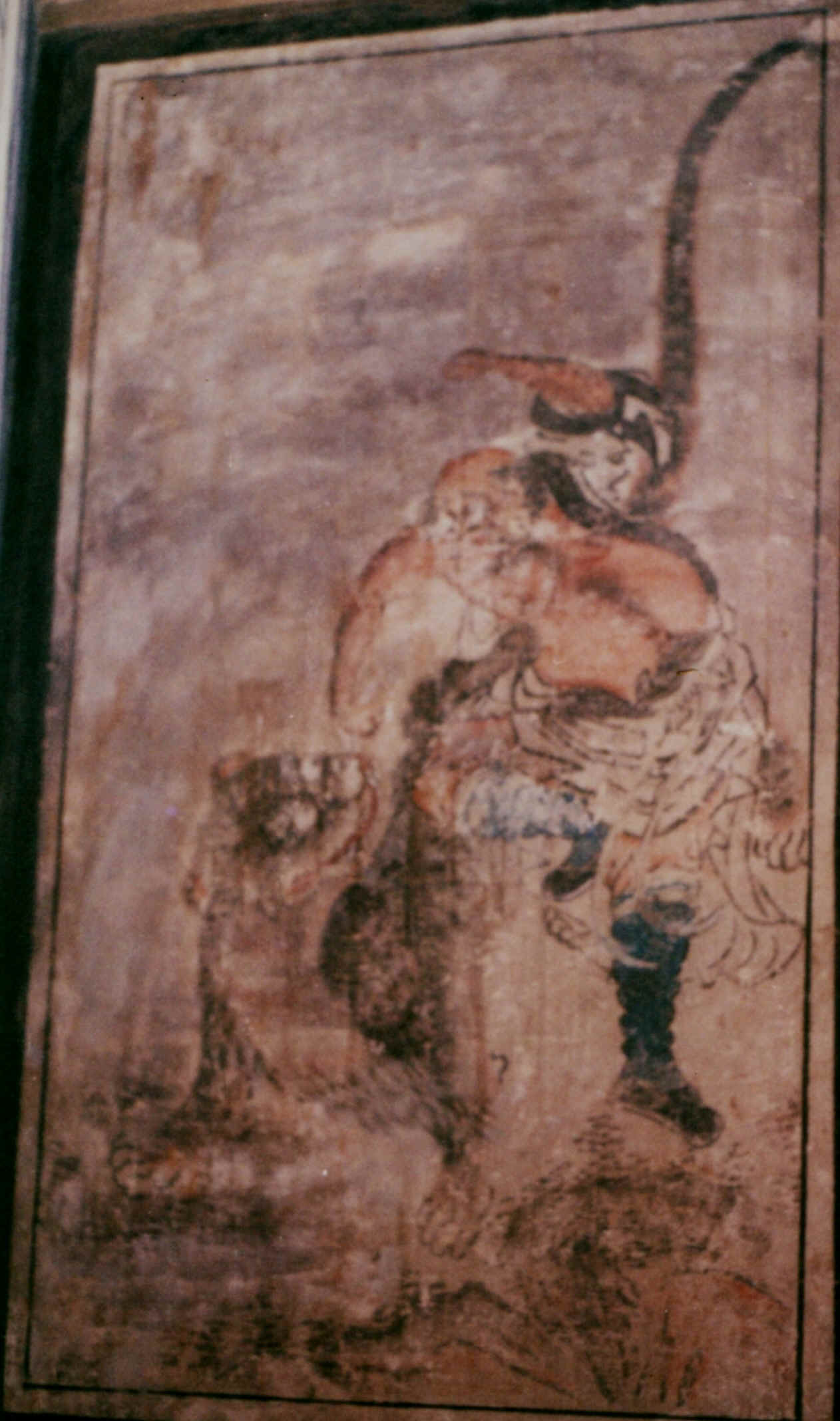 Besides, on the left and right sides of the shrine two Arhats respectively subduing dragons and taming tigers were drawn, which are also more suburb in skill compared with the former four drawings.
Besides, on the left and right sides of the shrine two Arhats respectively subduing dragons and taming tigers were drawn, which are also more suburb in skill compared with the former four drawings.
These murals provide valuable references for studying Shaolin martial arts, the layout of the temple before it was burned down and the legendary stories in the history of the temple. (click on pic for large version)
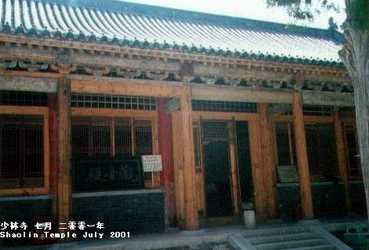 ‘Guanyin Hall, also named White Robe Hall, was built in the late Qing Dynasty. Inside the hall a wooden statue of the ‘White-Robed Bodhisvattva’ is inshrined. On the north & south walls of the hall are painted scenes of Shaolin monks in their martial arts practice. In the east part of the north and south walls are painted the images of Bodhisvattva Wenshu riding a green Lion and Bodhisvattva Puxian riding a white elephant. On the south & north sides of the shrine are painted two eminent Arhats, one subduing a dragon while the other taming a tiger. On the north part of the back wall is painted a mural showing how Emperor Lishimin of the Tang Dynasty was rescued by thirteen Shaolin monks. On the south part of the back wall is painted a mural showing how Bodhisvattva Kimnara scared away the insurgent troops.’
‘Guanyin Hall, also named White Robe Hall, was built in the late Qing Dynasty. Inside the hall a wooden statue of the ‘White-Robed Bodhisvattva’ is inshrined. On the north & south walls of the hall are painted scenes of Shaolin monks in their martial arts practice. In the east part of the north and south walls are painted the images of Bodhisvattva Wenshu riding a green Lion and Bodhisvattva Puxian riding a white elephant. On the south & north sides of the shrine are painted two eminent Arhats, one subduing a dragon while the other taming a tiger. On the north part of the back wall is painted a mural showing how Emperor Lishimin of the Tang Dynasty was rescued by thirteen Shaolin monks. On the south part of the back wall is painted a mural showing how Bodhisvattva Kimnara scared away the insurgent troops.’
Wenshu Dian;Manjusri Hall
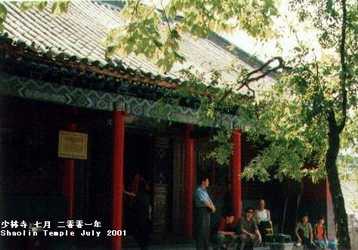 “In Wenshu Hall is enshrined the statue of Bodhisvattva Wenshu. Bodhisvattva Wenshu was renewed as the wisest among the numerous Buddhist bodhisvattvas. He always showed extraordinary talents and convincing eloquence in discussions and arguments at Bodhisvattvas meetings. Therefore he was also known as ‘Bodhisvattva the Great Master of Wisdom’.
“In Wenshu Hall is enshrined the statue of Bodhisvattva Wenshu. Bodhisvattva Wenshu was renewed as the wisest among the numerous Buddhist bodhisvattvas. He always showed extraordinary talents and convincing eloquence in discussions and arguments at Bodhisvattvas meetings. Therefore he was also known as ‘Bodhisvattva the Great Master of Wisdom’.
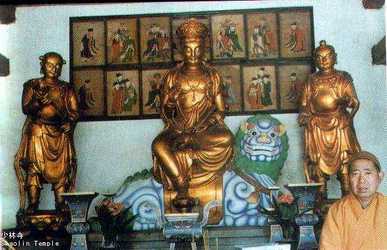
The statue of Bodhisvattva Wenshu.
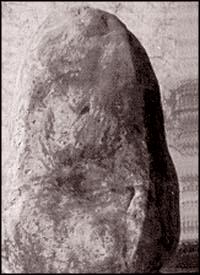 At the north end of the hall is enshrined the famous ‘Image Stone of Dhama Facing the Wall’. It was believed that this image was the result of his shadow being impressed on the stone while practicing Buddhism.” The B/W shows the stone as it was many years ago. One can still see the image fairly clear.
At the north end of the hall is enshrined the famous ‘Image Stone of Dhama Facing the Wall’. It was believed that this image was the result of his shadow being impressed on the stone while practicing Buddhism.” The B/W shows the stone as it was many years ago. One can still see the image fairly clear.
The pictures below show the stone in present condition, behind glass.
Pilu Dian; The ‘1000 Buddha Hall’
 1000 Buddha Hall, also named Pilu Pavilion, is to the north of Li Xue Ting. It was built in 1588 in the Ming Dynasty with the construction materials of other buildings dismantled by order of Empress Dowager Ci Sheng. Twice repaired in 1639 and 1775, it has been left with the architectural style. On the back of a glazed tablet set in the middle of the Great Ridge are thirteen characters meaning ‘ This 1000 Buddha Hall was renovated in mid autumn, 40th year in the reign of Emperor Qian Long’ (1775) Elegant carvings decorate the entire bridge.
1000 Buddha Hall, also named Pilu Pavilion, is to the north of Li Xue Ting. It was built in 1588 in the Ming Dynasty with the construction materials of other buildings dismantled by order of Empress Dowager Ci Sheng. Twice repaired in 1639 and 1775, it has been left with the architectural style. On the back of a glazed tablet set in the middle of the Great Ridge are thirteen characters meaning ‘ This 1000 Buddha Hall was renovated in mid autumn, 40th year in the reign of Emperor Qian Long’ (1775) Elegant carvings decorate the entire bridge.
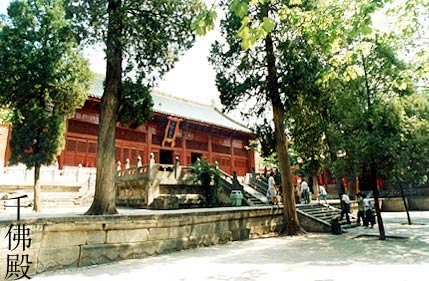 There is a vertical inscribed board, on which the words ‘Western Sage’ were written, placed above the entrance to the central rooms. The three central rooms are separated by partition boards, each with four doors. In front of the hall there is a spacious platform encircled by exquisite stone fences. Beneath the hall there are observation posts and a flight of steps.
There is a vertical inscribed board, on which the words ‘Western Sage’ were written, placed above the entrance to the central rooms. The three central rooms are separated by partition boards, each with four doors. In front of the hall there is a spacious platform encircled by exquisite stone fences. Beneath the hall there are observation posts and a flight of steps.
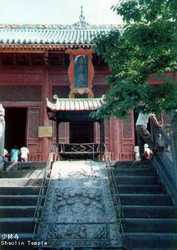
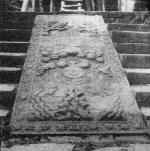 On the stone in the middle of those steps is Two Dragons playing with a Pearl in relief. Thin, floating clouds are carved in the middle of the relief; in the lower part are mountains, lotus blossoms and four red crowned cranes, which form a picture by itself.
On the stone in the middle of those steps is Two Dragons playing with a Pearl in relief. Thin, floating clouds are carved in the middle of the relief; in the lower part are mountains, lotus blossoms and four red crowned cranes, which form a picture by itself.
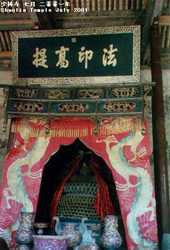
 In the middle of the Hall a bronze statue of Buddha Pilu is sitting on a throne of lotus blooms os consecrated in a shrine. In the eastern part of the hall was a table, on which stands Amida Buddha carved in white marble and vouchsafed by the prince on Zhou in 1409. Bodhidharma’s ‘Shadow Rock’ was once kept here as well.
In the middle of the Hall a bronze statue of Buddha Pilu is sitting on a throne of lotus blooms os consecrated in a shrine. In the eastern part of the hall was a table, on which stands Amida Buddha carved in white marble and vouchsafed by the prince on Zhou in 1409. Bodhidharma’s ‘Shadow Rock’ was once kept here as well.
 Five Hundred Arhats Worshipping Pilu, a drawing of about 320 square meters in size, is frescoed on the east, west and north walls of the hall; the background of the drawing is made with mountains, waters, floating clouds and mist. The five hundred Arhats are presented in three sections: upper, middle and lower, each consisting of a number of figures. Some of the Arhats are seen subduing dragons and tigers, others are indulging themselves in animated talking, a few holding their alms bowls casting a spell, and still others are all ears in audience with their master. All are vivid and lifelike in their various postures. Arthur, a sound transliterated from Sanskrit, means a monk who has cultivated himself in Buddhism so well that he has at last risen from the mortals. In the Buddhist world an arhat is next only to a Bodhisvattva, the mural was painted in strong color, the lines are very neat and vigorous. Such a view is rarely seen among murals of the same kind in China. No chronological record or inscriptions are found on it. Most people regard it as a Ming Dynasty work.
Five Hundred Arhats Worshipping Pilu, a drawing of about 320 square meters in size, is frescoed on the east, west and north walls of the hall; the background of the drawing is made with mountains, waters, floating clouds and mist. The five hundred Arhats are presented in three sections: upper, middle and lower, each consisting of a number of figures. Some of the Arhats are seen subduing dragons and tigers, others are indulging themselves in animated talking, a few holding their alms bowls casting a spell, and still others are all ears in audience with their master. All are vivid and lifelike in their various postures. Arthur, a sound transliterated from Sanskrit, means a monk who has cultivated himself in Buddhism so well that he has at last risen from the mortals. In the Buddhist world an arhat is next only to a Bodhisvattva, the mural was painted in strong color, the lines are very neat and vigorous. Such a view is rarely seen among murals of the same kind in China. No chronological record or inscriptions are found on it. Most people regard it as a Ming Dynasty work.
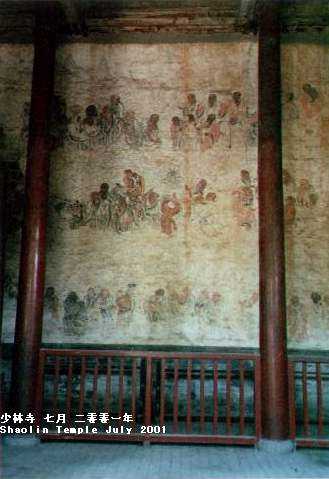
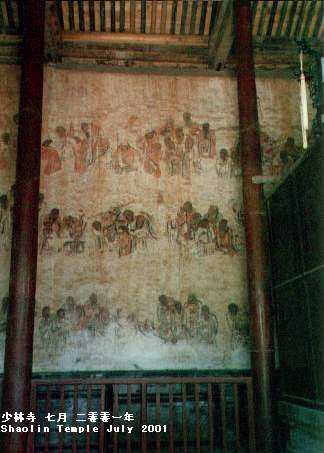
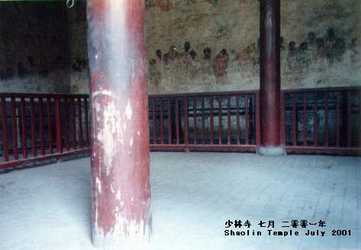
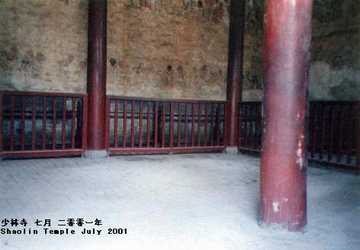
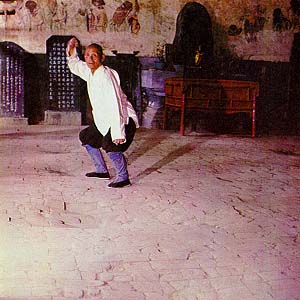 Inside the hall there are 48 foot print impressions, which were the result of the wear and tear by feet of monks consistently practicing martial arts trough the centuries. The deepest impressions can be found at the front of the row; those at the back are much less deep. It is said that this is because the best martial monks, those who had the most powerful steps, were standing at the front. One of the guides of the temple jokingly said that the present day monks are not able to make similar footprints, not even if they kept going at it for a 100 years… Up ’till a few years ago it was possible to actually enter the hall and ‘touch’ the footsteps and watch the murals up close, but apparently the floor was deteriorating because of the big number of visitors.
Inside the hall there are 48 foot print impressions, which were the result of the wear and tear by feet of monks consistently practicing martial arts trough the centuries. The deepest impressions can be found at the front of the row; those at the back are much less deep. It is said that this is because the best martial monks, those who had the most powerful steps, were standing at the front. One of the guides of the temple jokingly said that the present day monks are not able to make similar footprints, not even if they kept going at it for a 100 years… Up ’till a few years ago it was possible to actually enter the hall and ‘touch’ the footsteps and watch the murals up close, but apparently the floor was deteriorating because of the big number of visitors.
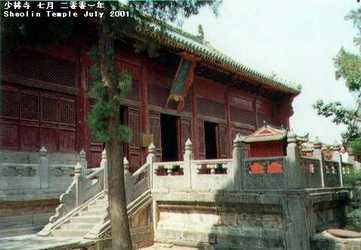 “Pilu Pavilion, also named 1000 Buddha Hall, has got its name because of the bronze statue of Buddha Pilu, which was cast in the Ming Dynasty, is enshrined inside it. Above the statue there is a board bearing four Chinese characters “PHA Yin Gao Ti” (Uphold high the Buddha’s Seal), handwritten by Emperor Qianlong personally. On the east, north and west sides of the hall is an enormous colour fresco depicting the story of “Five hundred Arhats Worshipping Pilu”, painted by artists of Ming Dynasty. On the brick wall are left 48 foot print depressions, which have resulted from the monks arduous pugilistic practice in the past several centuries. These depressions on the brick floor are popularly known as “Foot Kungfu Depressions”.”
“Pilu Pavilion, also named 1000 Buddha Hall, has got its name because of the bronze statue of Buddha Pilu, which was cast in the Ming Dynasty, is enshrined inside it. Above the statue there is a board bearing four Chinese characters “PHA Yin Gao Ti” (Uphold high the Buddha’s Seal), handwritten by Emperor Qianlong personally. On the east, north and west sides of the hall is an enormous colour fresco depicting the story of “Five hundred Arhats Worshipping Pilu”, painted by artists of Ming Dynasty. On the brick wall are left 48 foot print depressions, which have resulted from the monks arduous pugilistic practice in the past several centuries. These depressions on the brick floor are popularly known as “Foot Kungfu Depressions”.”
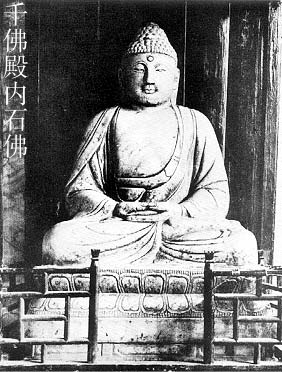
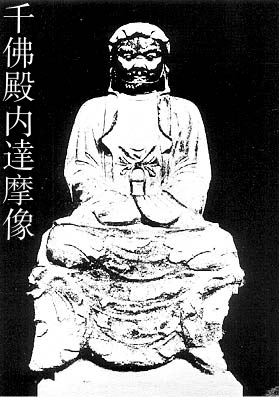 An image of Damo and Buddha that were once kept inside the 1000 Buddha Hall.
An image of Damo and Buddha that were once kept inside the 1000 Buddha Hall.
Behind the scenes: Monks quarters.
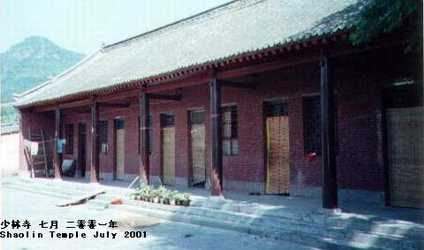 Leaving the ‘public area’ somewhere on the west side one can see the residential area. It was my impression that the people living the building in this particular building were living there on a temporarily basis. There were a few foreigners around: they were not living there and have leave in the evening: I was told that foreigners are not allowed to spend the night at Shaolin.
Leaving the ‘public area’ somewhere on the west side one can see the residential area. It was my impression that the people living the building in this particular building were living there on a temporarily basis. There were a few foreigners around: they were not living there and have leave in the evening: I was told that foreigners are not allowed to spend the night at Shaolin.
Walking north and then east around the back, this is what you see. A less romantic view of the temple.
Then behind the Pilu Hall these kids were training. So the legend continues … Or does it? These boys live in the temple for a annual fee of 3000 Yuan. May not see much, but is a lot of money for the average Chinese. Some of the boys trained bare footed. One of the bigger boys acted as their teacher, because he is older than them. He has been practicing Shaolin inside the temple for 1,5 years (2001), some of the smaller kids 2 years or longer. His teaching methods were interesting: screaming and threatening the kids. Kicking and slapping them into the right positions. One of the kids who was visibly having troubles doing it right got beaten up. A few minutes later he said he wasn’t able to train anymore because he couldn’t see anymore! The guy hit him so hard on the eyes that they were so swollen up to an extent that he simply couldn’t see anything. So far for the Martial Ethics at the temple …
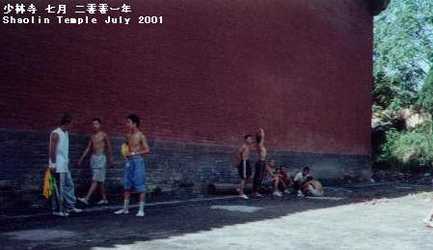
When I started taking pictures they all because shy suddenly and started walking away. The smaller boys I saw later that they again when they were resting at another place in the monks quarters. The ‘big guy’ I met later in the evening when I saw him with his girlfriend. Suddenly he was very shy and all; very different form that morning.
Walking around the back one finally sees the ‘driveway’ of the temple. Some garages for the temple cars are here as well (Didn’t see Abbot Shi Yongxin’s Mercedes though)
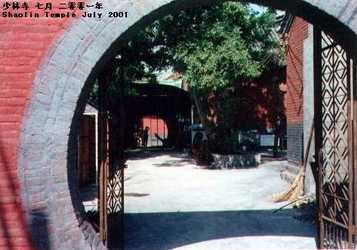
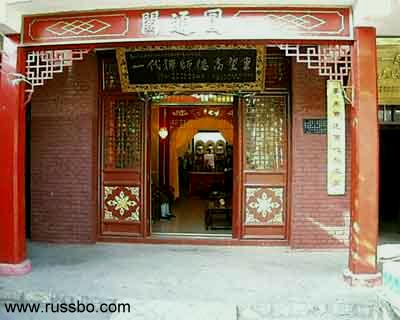 Shi Suxi used to live here before he became the Abbot of the Southern Shaolin Temple in Putian, Fujian province. He has since returned here and passed away.
Shi Suxi used to live here before he became the Abbot of the Southern Shaolin Temple in Putian, Fujian province. He has since returned here and passed away.
Talin; The burialplace of the Shaolin Temple.
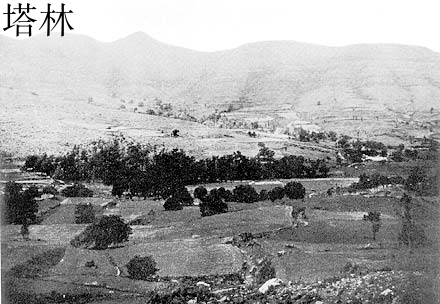 The Forest of Pagodas is situated on the north bank of Shaoxi Stream, covering an area of over 21,000 square meters. There are 230 pagodas built in the Tang, Song, Jin, Yuan, Ming and Qing Dynasties. It is the largest forest of pagoda’s known in China.
The Forest of Pagodas is situated on the north bank of Shaoxi Stream, covering an area of over 21,000 square meters. There are 230 pagodas built in the Tang, Song, Jin, Yuan, Ming and Qing Dynasties. It is the largest forest of pagoda’s known in China.
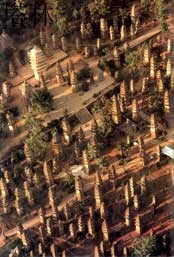 Pagoda means tomb in ancient India. The pagodas in this cemetery are of brick, stone and brick and stone structures. Two of them were built in the Tang Dynasty; two in the Song Dynasty, ten in the Jin, 46 in the Yuan and 148 in the Ming Dynasty. The rest of them were built either in the Qing Dynasty of other unknown dynasties.
Pagoda means tomb in ancient India. The pagodas in this cemetery are of brick, stone and brick and stone structures. Two of them were built in the Tang Dynasty; two in the Song Dynasty, ten in the Jin, 46 in the Yuan and 148 in the Ming Dynasty. The rest of them were built either in the Qing Dynasty of other unknown dynasties. 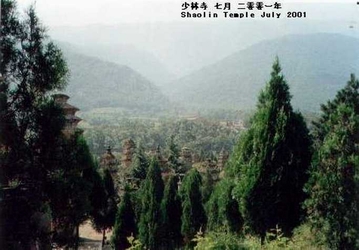 Architecturally, they are classed as one-story with single eaves, one story with multiple eaves, stupas and various types of Lamaist pagoda’s. this grand architectural complex indeed provides valuable material for studying the history of Chinese architecture, art and religion; and it is also a famous scenic spot.
Architecturally, they are classed as one-story with single eaves, one story with multiple eaves, stupas and various types of Lamaist pagoda’s. this grand architectural complex indeed provides valuable material for studying the history of Chinese architecture, art and religion; and it is also a famous scenic spot.
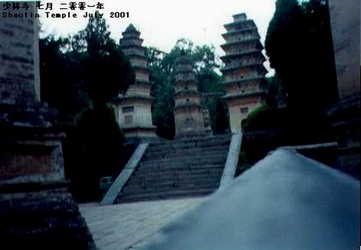
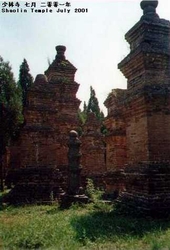 The oldest brick pagoda was built for Master Fa Wan, built in the Tang Dynasty (791). He was from Jing’ai Temple in Luoyang. There are many interesting pagodas to be found: too many to describe here. Many other pagoda’s from later periods can be found in the yard. Recently deceased eminent monks also found their resting place here. Abbot of the Southern Shoaling temple and one of the oldest Shoaling monks alive today, Shi Suxi, is having a pagoda built in preparation.
The oldest brick pagoda was built for Master Fa Wan, built in the Tang Dynasty (791). He was from Jing’ai Temple in Luoyang. There are many interesting pagodas to be found: too many to describe here. Many other pagoda’s from later periods can be found in the yard. Recently deceased eminent monks also found their resting place here. Abbot of the Southern Shoaling temple and one of the oldest Shoaling monks alive today, Shi Suxi, is having a pagoda built in preparation.
Chuzu An; Damo Pavilion
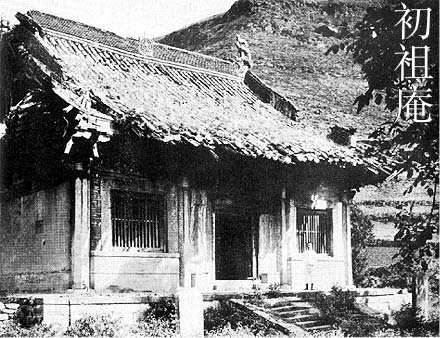 Damo Pavilion is situated on a hill at the front of Wu Ru Feng (Five Breast Peak), a small scaled architectural complex, set up in the Song Dynasty in memory of Damo’s mediation here. Some people say that it was here that he sat in meditation. For example the inscription on the tablet Boundless Beneficence set up in 1605 says, This pavilion marks the place where our Buddhist saint meditated facing the wall.
Damo Pavilion is situated on a hill at the front of Wu Ru Feng (Five Breast Peak), a small scaled architectural complex, set up in the Song Dynasty in memory of Damo’s mediation here. Some people say that it was here that he sat in meditation. For example the inscription on the tablet Boundless Beneficence set up in 1605 says, This pavilion marks the place where our Buddhist saint meditated facing the wall.
From the Shaolin temple to the Damo Pavilion there is section that has a stone path 170 meters long, built by a monk, about 80 years old, named Xing Xa. He also paved a 190 meter path from Damo Pavilion to the Damo Cave. Xing Xa died in 1979, but the path will remain.
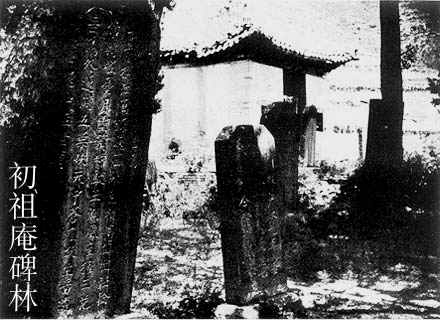 Damo Pavilion is bordered by gullies on three sides, with Wu Ru Feng behind it. It is a quiet, tasteful place.
Damo Pavilion is bordered by gullies on three sides, with Wu Ru Feng behind it. It is a quiet, tasteful place.
The construction made full use of the topographical advantages. The Entrance, the Big Hall and the Thousand Buddha Pavilion, all stand in the northern Song Dynasty; other buildings have been rebuild by later generations. Behind the Big Hall there are two small pavilions. Now over 40 inscriptions are preserved in Damo Pavilion.
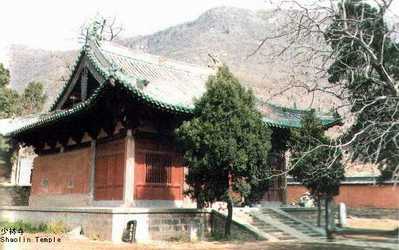 The Big Hall, 10.9×10.9 m, covers a floor space of about 118 square meters. Though called ‘Big Hall’ , it is not very big in size. But it attracts attention from academic circles because it considered as the oldest and most valuable wooden structures in Henan province.
The Big Hall, 10.9×10.9 m, covers a floor space of about 118 square meters. Though called ‘Big Hall’ , it is not very big in size. But it attracts attention from academic circles because it considered as the oldest and most valuable wooden structures in Henan province.
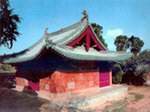 The Big Hall was built in the Late Northern Song Dynasty. The words on one of the pillars in the front of the hall tell that it was built in 1125. Though it has been renovated several times, its main architectural components and features remain the same as the original.
The Big Hall was built in the Late Northern Song Dynasty. The words on one of the pillars in the front of the hall tell that it was built in 1125. Though it has been renovated several times, its main architectural components and features remain the same as the original.
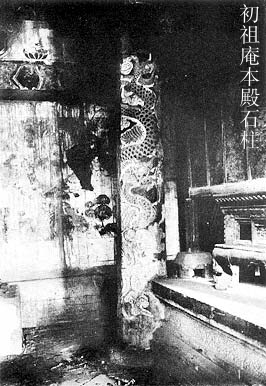
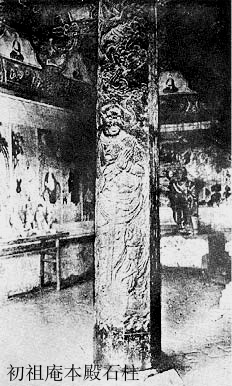 According to ancient Chinese architecture the style of Damo Pavilion belongs to what is called the ‘nine ridge pavilion’. Its plan is nearly square. It has 12 carved pillars. Inside there are 4 more pillars carved with portraits of Heavenly Kings. In between the 4 pillars stands a carved stone stage. Inside the wooden shrine on the stage is consecrated a statue of Damo. Both the frame work of the building and the proportion of the brackets tell of its antique features. Most attractive are the pillars propping the eaves, the inside pillars, the carved stones supporting the wall and the exquisite relief’s around the stage.
According to ancient Chinese architecture the style of Damo Pavilion belongs to what is called the ‘nine ridge pavilion’. Its plan is nearly square. It has 12 carved pillars. Inside there are 4 more pillars carved with portraits of Heavenly Kings. In between the 4 pillars stands a carved stone stage. Inside the wooden shrine on the stage is consecrated a statue of Damo. Both the frame work of the building and the proportion of the brackets tell of its antique features. Most attractive are the pillars propping the eaves, the inside pillars, the carved stones supporting the wall and the exquisite relief’s around the stage.
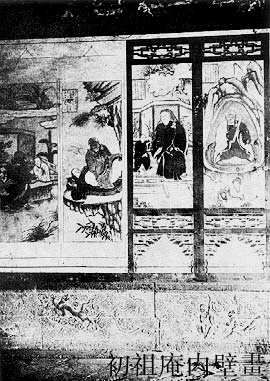 The pillars propping up the eaves are octagonal. Three of the inner sides, as well as three outer ones, can bee seen, and they all follow a unified pattern. The pillars on both sides of the front door are carved with dancers and singers, with flowers of pomegranate twining round the twigs. Such pattern is among the noblest of Buddhist designs. The front sides of both pillars are carved into life like dancing gods playing the pipa, cymbal, sheng (Chinese wind pipe), xiao (Chinese vertical flute) etc.
The pillars propping up the eaves are octagonal. Three of the inner sides, as well as three outer ones, can bee seen, and they all follow a unified pattern. The pillars on both sides of the front door are carved with dancers and singers, with flowers of pomegranate twining round the twigs. Such pattern is among the noblest of Buddhist designs. The front sides of both pillars are carved into life like dancing gods playing the pipa, cymbal, sheng (Chinese wind pipe), xiao (Chinese vertical flute) etc.
On the foundation stones of the east, west and north walls, both inside and outside the hall, are also carved exquisite pictures of human figures, animals, gods and devils and treasured mountains, with water waves serving as foils. Most of the pictures of animals are outside the hall; while pictures with human forms are mostly on the walls inside the hall.
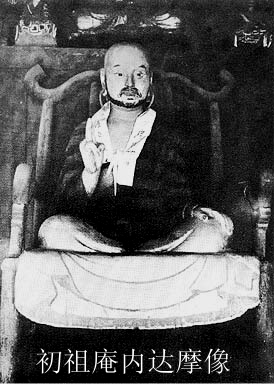
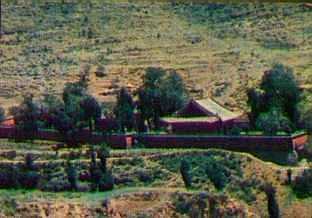
To the north of Damo Pavilion are two small ones, square in shape, standing side by side. It is said that the one lying west is the place where Damo meditated facing the wall, and that the east pavilion one housed the images of his venerable parents.
Over 40 ancient tablets are kept in Damo Pavilion, such as; Eulogy on Damo, tablet with inscription Convent where Damo meditated, tablet with the image of Guanyin, tablet inscribed with Buddhist scriptures in Sanskrit and an image of Damo and a tablet of Hui Neng Planting a cypress. Damo Pavilion is now inhabited by nuns of Shaolin.
Damo Dong; The Cave of Damo
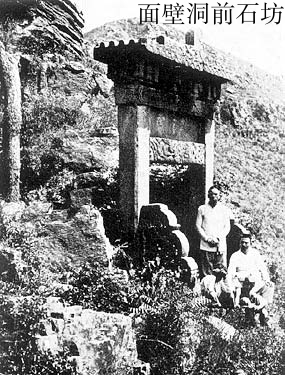
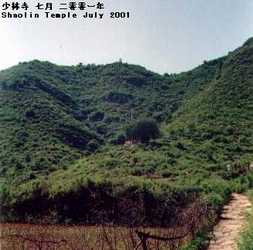 Ascending Wu Ru Feng along mountain path north of Damo Pavilion, one sees a memorial gateway built in 1604 (during the reign of Emperor Shen Zong of the Ming Dynasty.).
Ascending Wu Ru Feng along mountain path north of Damo Pavilion, one sees a memorial gateway built in 1604 (during the reign of Emperor Shen Zong of the Ming Dynasty.).
Behind it, several meters away, is the cave where Damo faced the wall for nine years, according legend. In front of the gateway there are three Chinese characters; Mo Xuan Chu, meaning Where mediation leads to wonder, in the handwriting of a court literator named Hu Bin.
On its reverse is written; Dong Lai Zhao Ji, meaning He came to this eastern mountain and left his merits, written by Du Jinxi. Both inscriptions are decorated with Two Dragons Playing a Pearl and other geometrical designs.
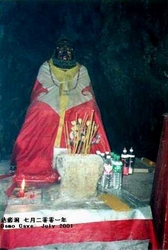
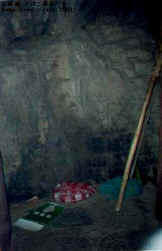 The cave is over six meters deep, dug on the edge of a cliff. Inside it a stone statue of Damo is well preserved. There are three stone tablets outside the cave respectively set up in 1605 (Ming Dynasty), 1737 (Qing Dynasty) and in 1917. The picture on the right shows the place were the ‘Shadow Rock’ was chiselled out.
The cave is over six meters deep, dug on the edge of a cliff. Inside it a stone statue of Damo is well preserved. There are three stone tablets outside the cave respectively set up in 1605 (Ming Dynasty), 1737 (Qing Dynasty) and in 1917. The picture on the right shows the place were the ‘Shadow Rock’ was chiselled out.
Poet Cao Wenheng ‘Visiting Damo Cave in Five Breast Peak’
Who was it that dug the cave
Right in the Five Breast Peak
That Damo could contemplate
In all the peace of peace?
So high it rests, oh, near the stars.
Above the streaming clouds;
Though Time may change, it never does,
The cave, with his deeds and vows.
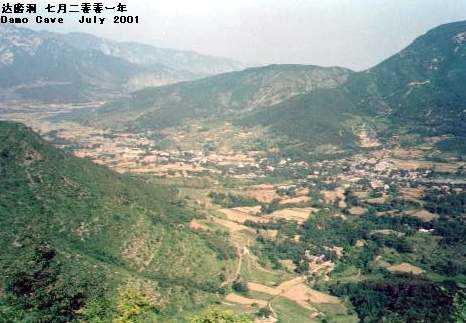
Jia Kaizong ‘Damo Cave’
Straight to the highest peak I ride
Through layers of clouds a floating by,
And stop to marvel at the cave
That’s dug by a dragon said from high.
It is said that before Damo began his Buddhist cultivation in Songshan Mountain, there had been a mountain cave made by a dragon; and that at the time Damo entered the cave to meditate, a fiery dragon withdrew from the crack. The wavy surfaced rock inside the cave is allegedly due to the squirming movements of the dragon; and people say that a cliff called Yang Long Ya (Nursing dragon Cliff) still exists to the west of the cave. All these are made up stories to extol Damo’s extraordinary achievements in Buddhism. The so-called Shadow Rock left there by Damo is nothing more than an ordinary piece of veined stone.
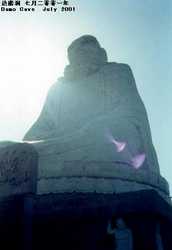
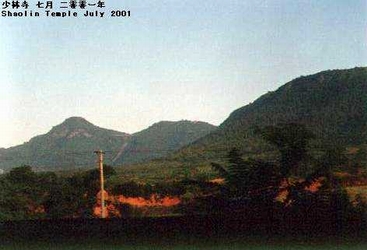 A few steps higher up the mountain a large statue of Damo can be found. Built in 1997 and its head is already cracked. Made of white marble, which was supposed et feel cold when touched. Which it didn’t when I was there; it was pretty warm that day though …. Picture on the right is a view on Wu Ru Feng from the Shaolin Wushu Hotel; the white Damo statue is visible when you’re actually there.
A few steps higher up the mountain a large statue of Damo can be found. Built in 1997 and its head is already cracked. Made of white marble, which was supposed et feel cold when touched. Which it didn’t when I was there; it was pretty warm that day though …. Picture on the right is a view on Wu Ru Feng from the Shaolin Wushu Hotel; the white Damo statue is visible when you’re actually there.
The Four Surviving Monks
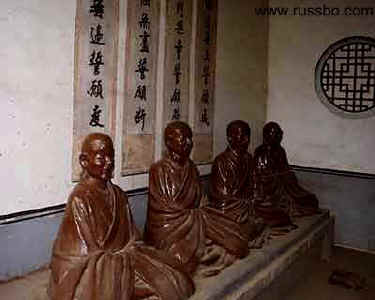 Four monks which lived in or around the temple when the people’s republic was founded, returned to the temple when Buddhism was reestablished. They were, if I’m not mistaken:
Four monks which lived in or around the temple when the people’s republic was founded, returned to the temple when Buddhism was reestablished. They were, if I’m not mistaken:
Shi Wanheng 释萬恆
Shi Dechan 释德禅 (1907 – 1993)
Shi Suxi 释素喜 (1924 – 2006)
Shi Xingzheng 释行正 (1914 – 1987
Shi Suxi is of the 30th generation of monks in the Shaolin temple. It is from them that the present day fighting monks get their pedigree. A statue of the four of them can also be found inside the Chuipu Hall (Kung Fu Hall) in the temple. I’m looking for more info on them …
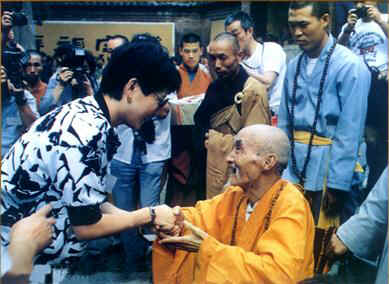
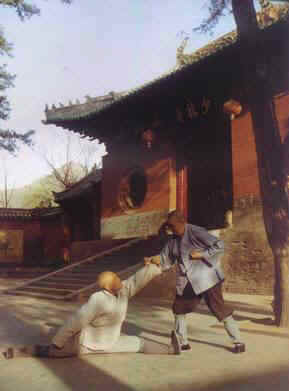
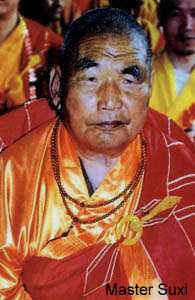 Shi Suxi. He is was also the abbot of the Southern Shaolin Temple in Putian, Fujian. It was there that I met him in person.
Shi Suxi. He is was also the abbot of the Southern Shaolin Temple in Putian, Fujian. It was there that I met him in person.
Shi Su Yun:
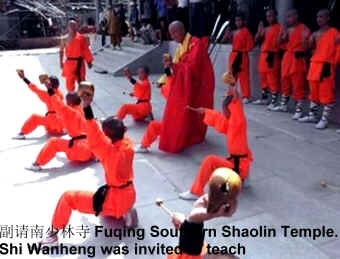 Shi Wanheng teaching in Fuqing Southern Shaolin Temple.
Shi Wanheng teaching in Fuqing Southern Shaolin Temple.
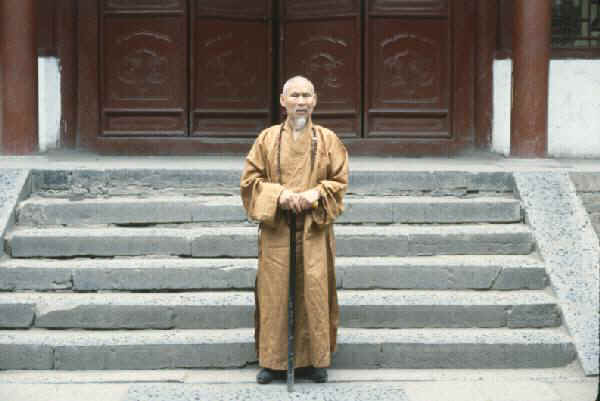
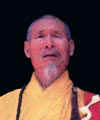 Shi Xingzheng (1914-1987)
Shi Xingzheng (1914-1987)
In 1928, a warlord named Shi Yousan fired on and burned the temple for over 45 days. Abbot Xingzheng saved many books and sutras in the Shaolin Temple library from destruction by burying them underground. During one attack, while trying to retrieve more texts from the library, some debris hit his left eye, which he lost use of.
